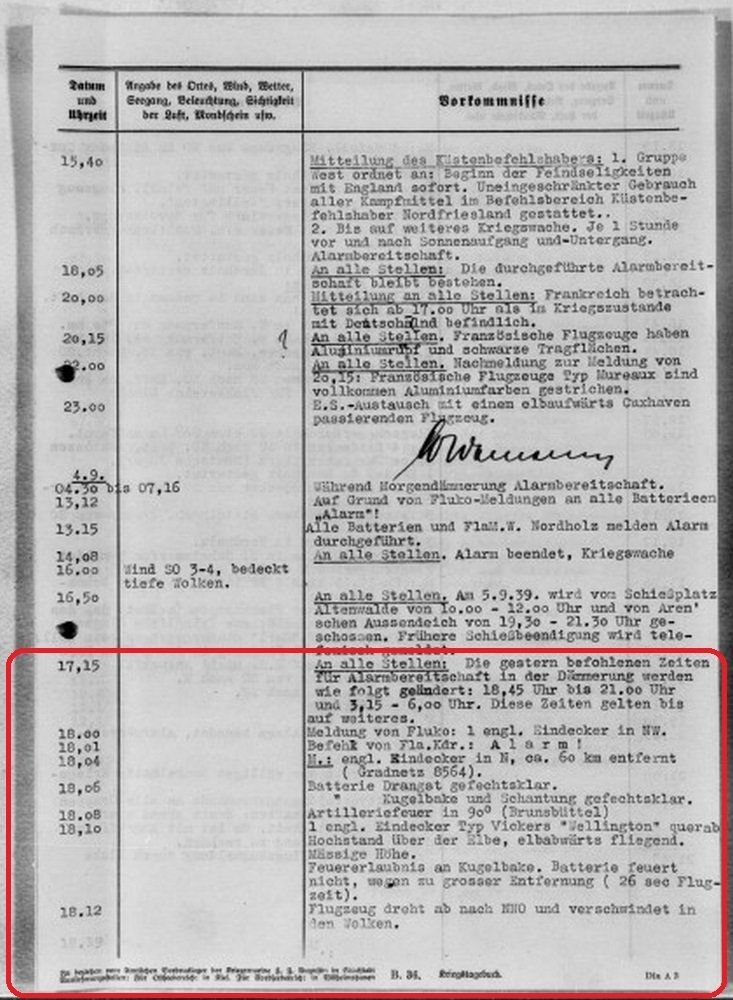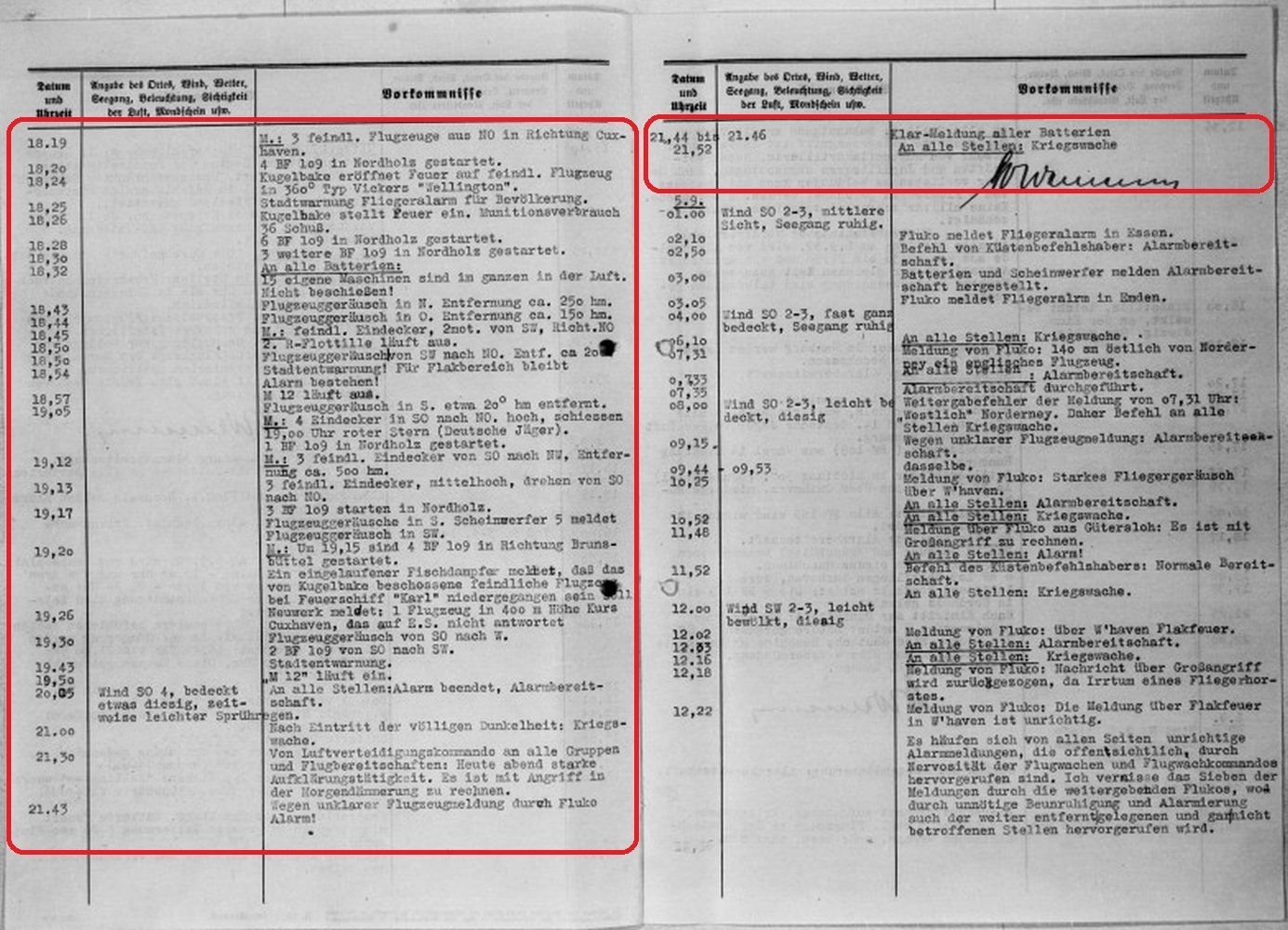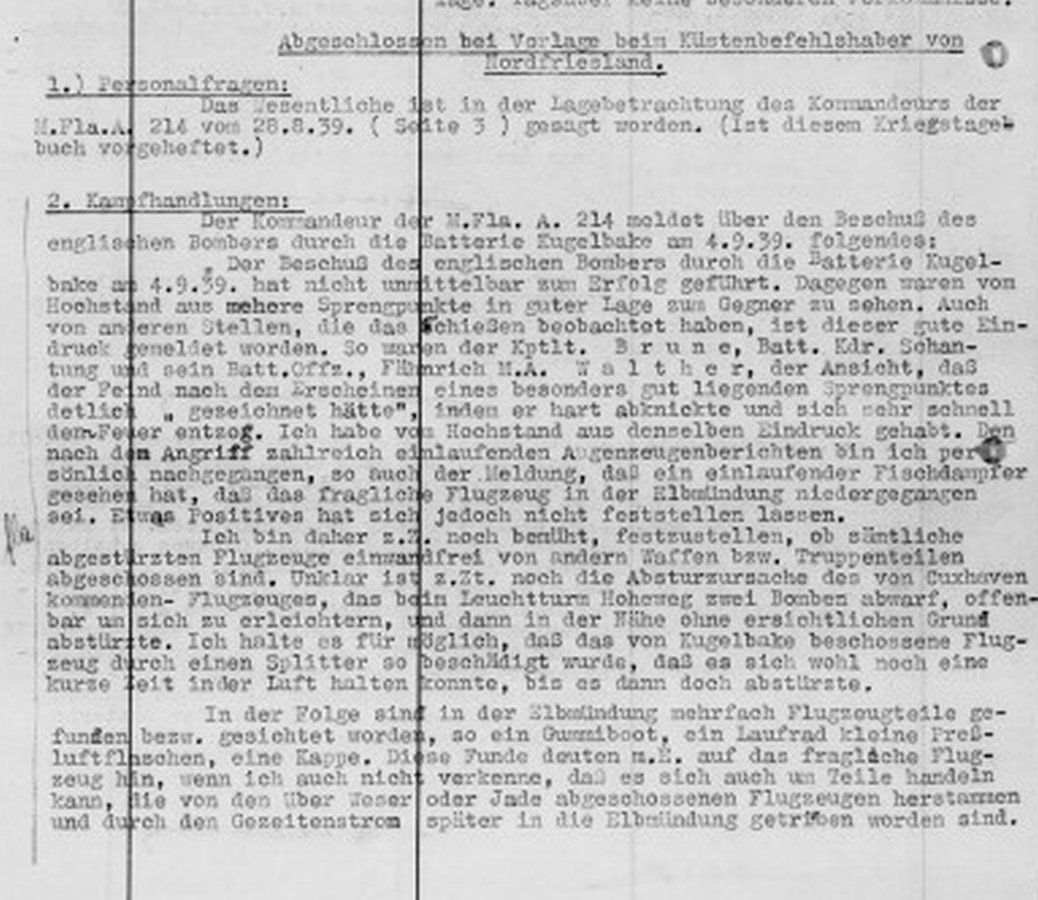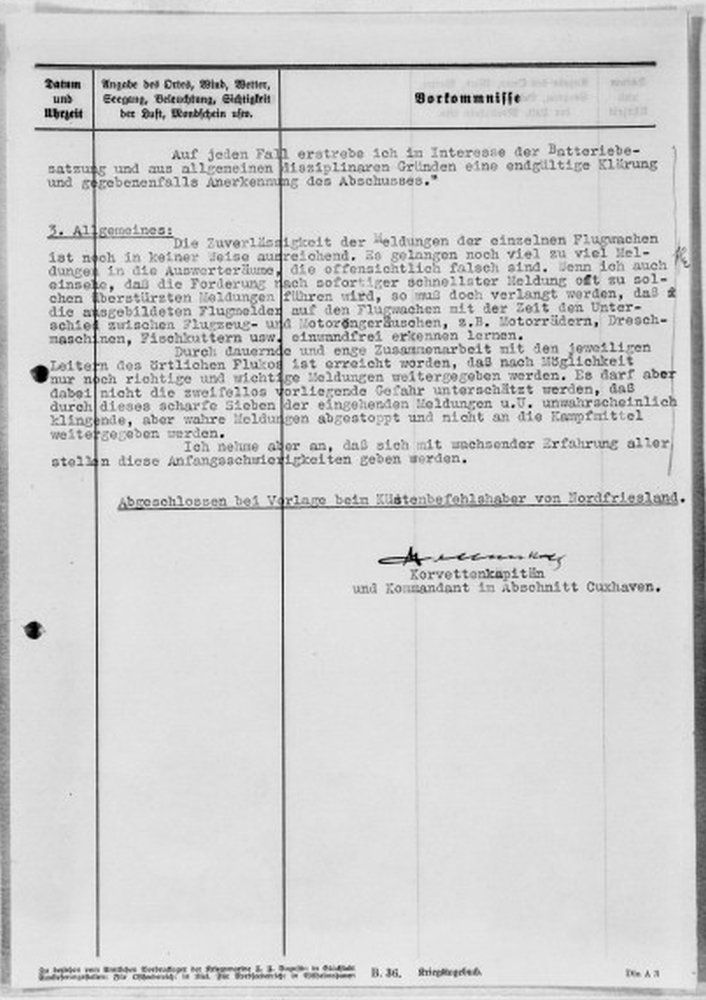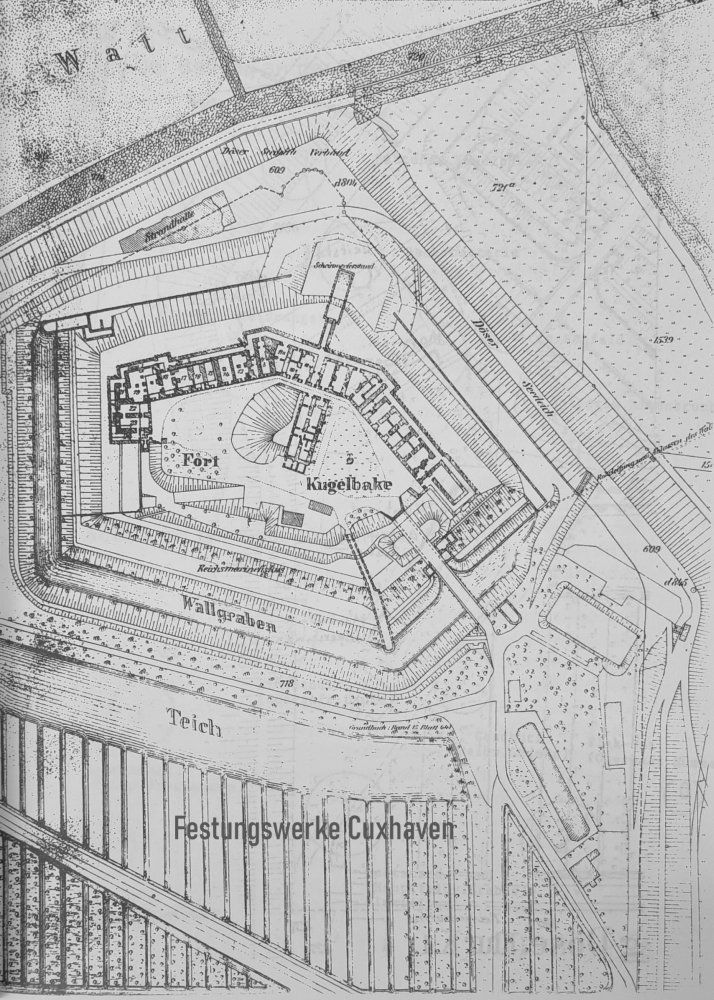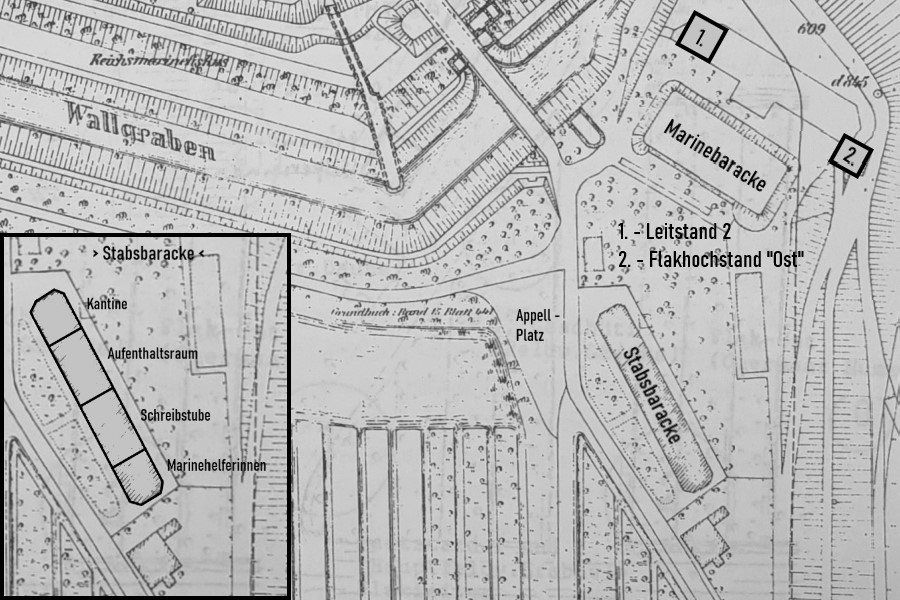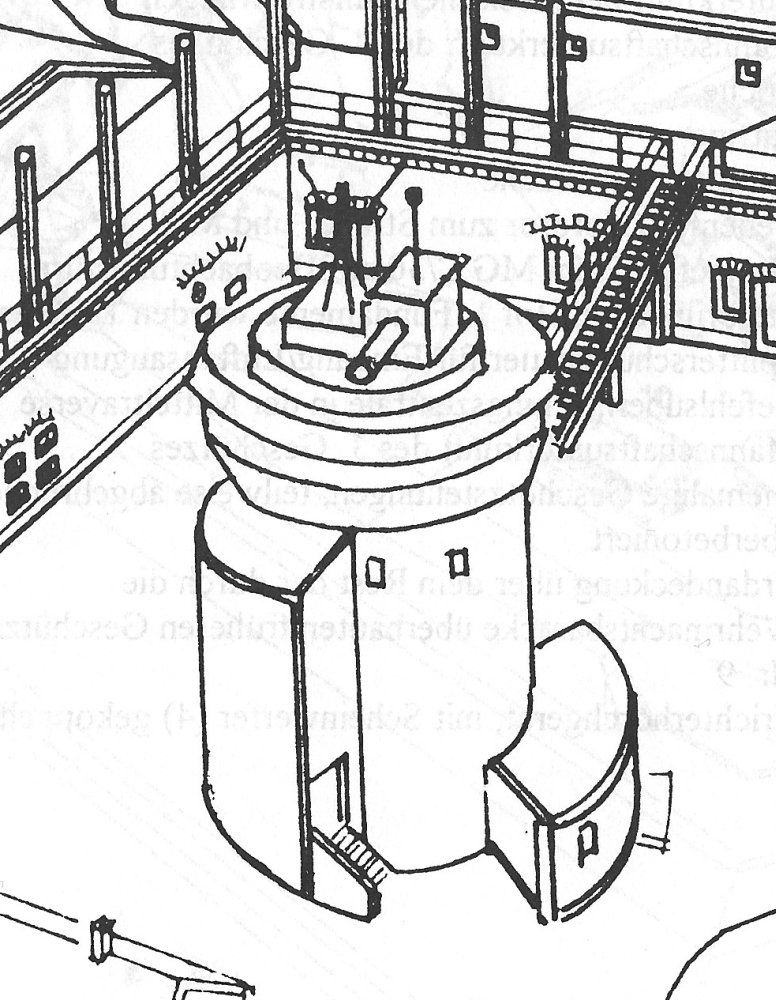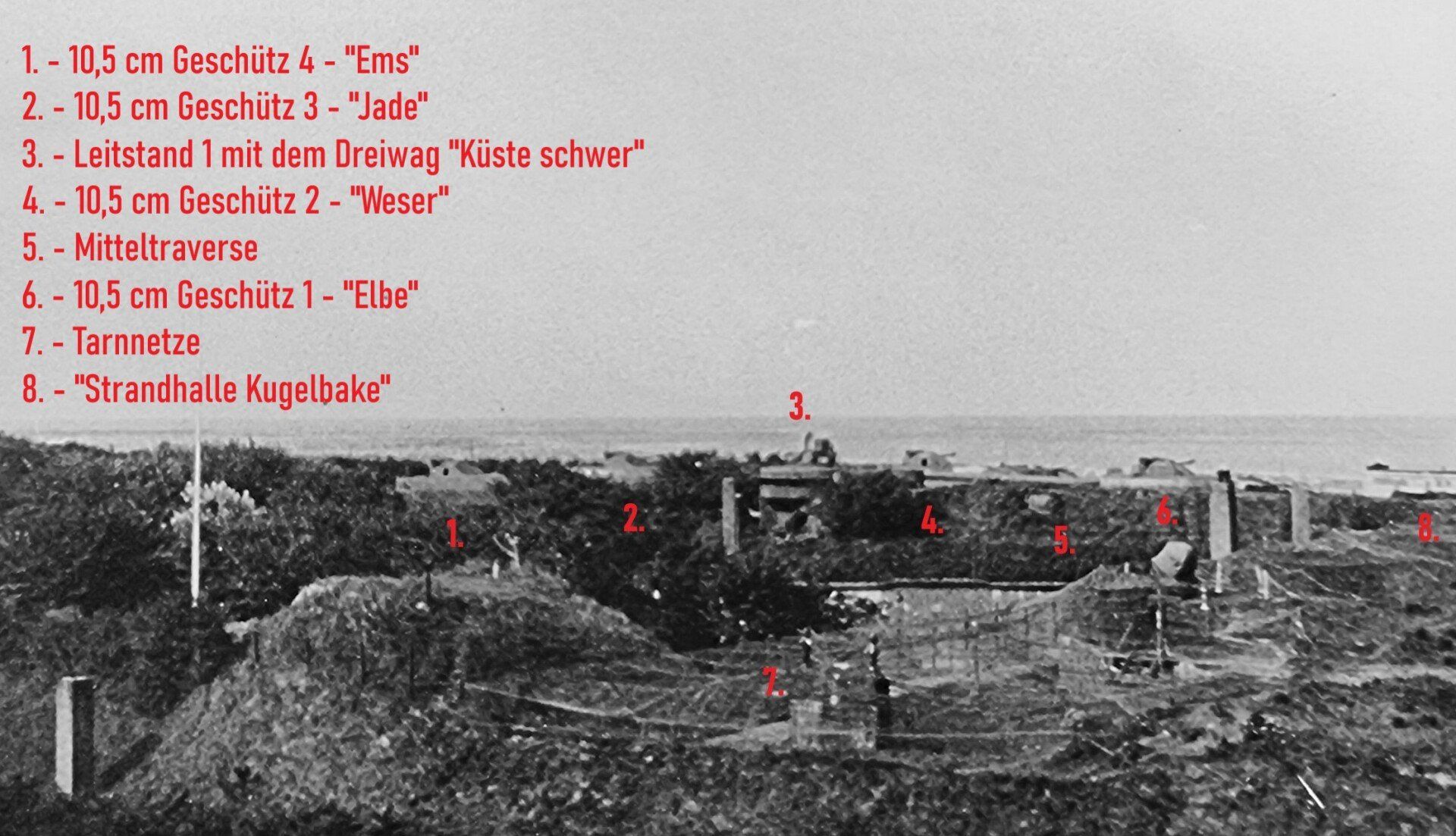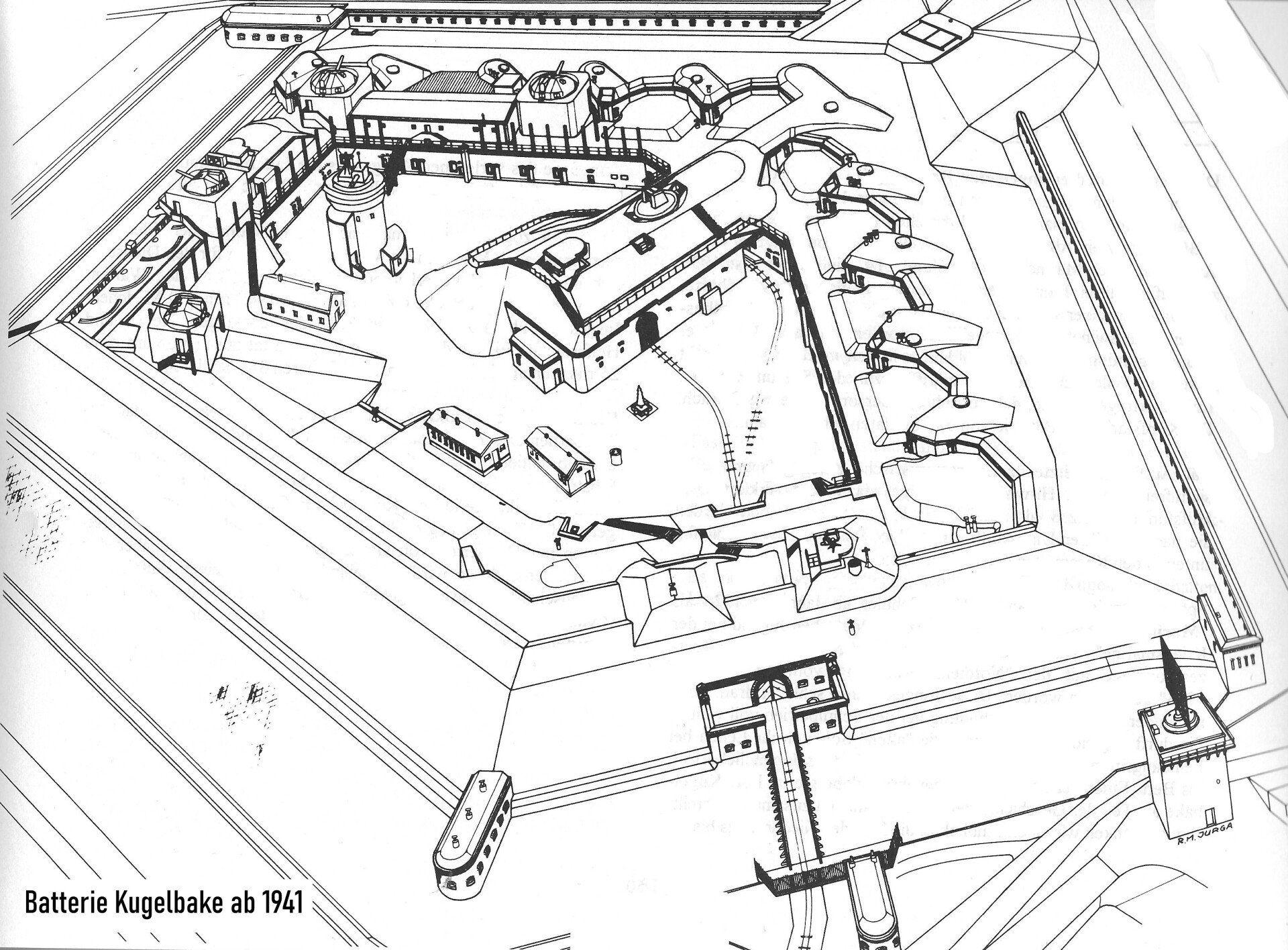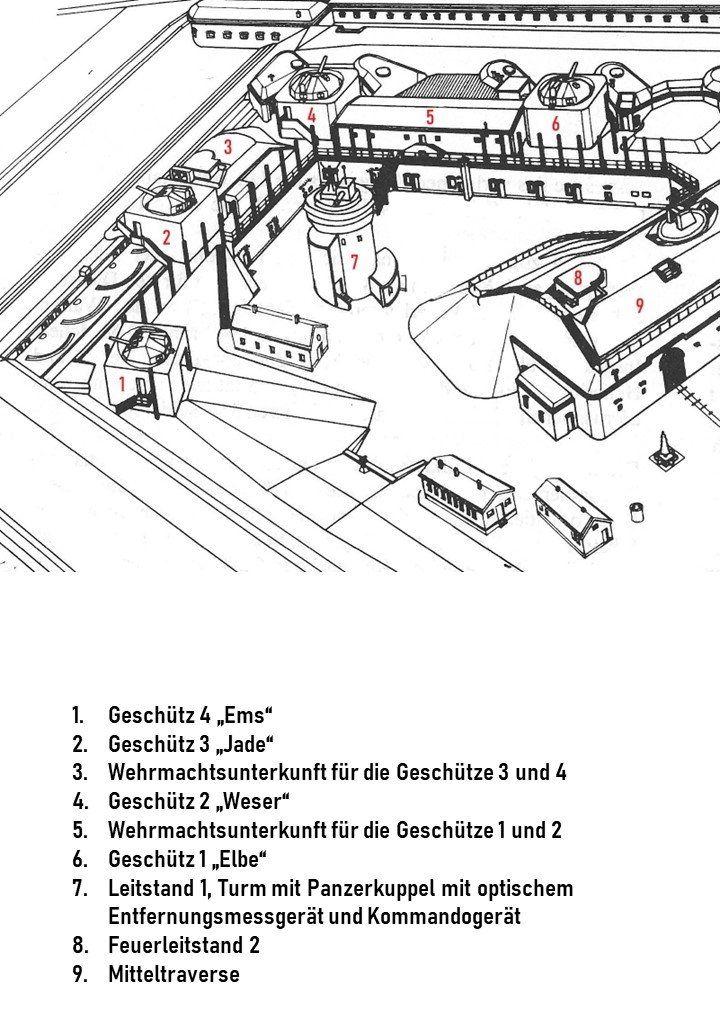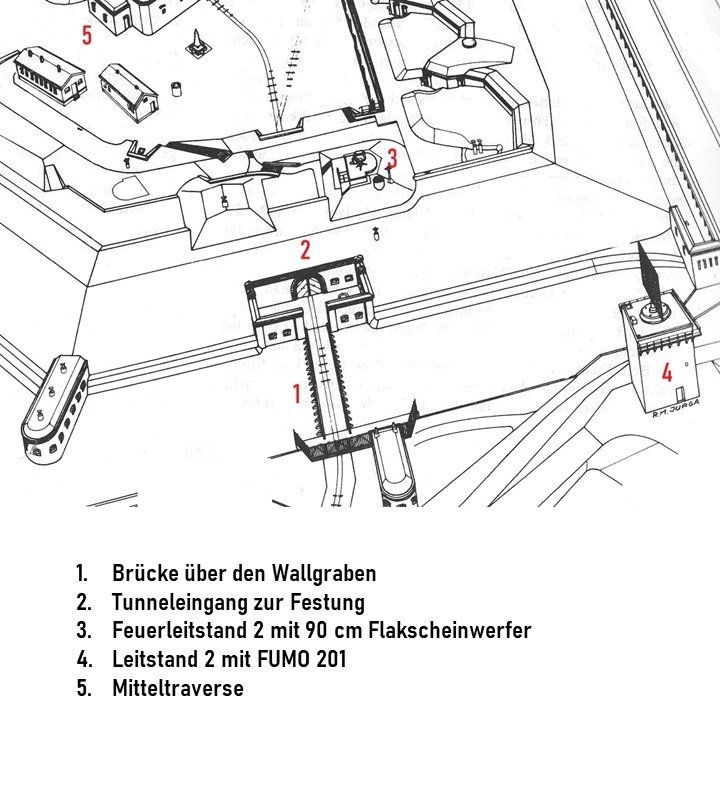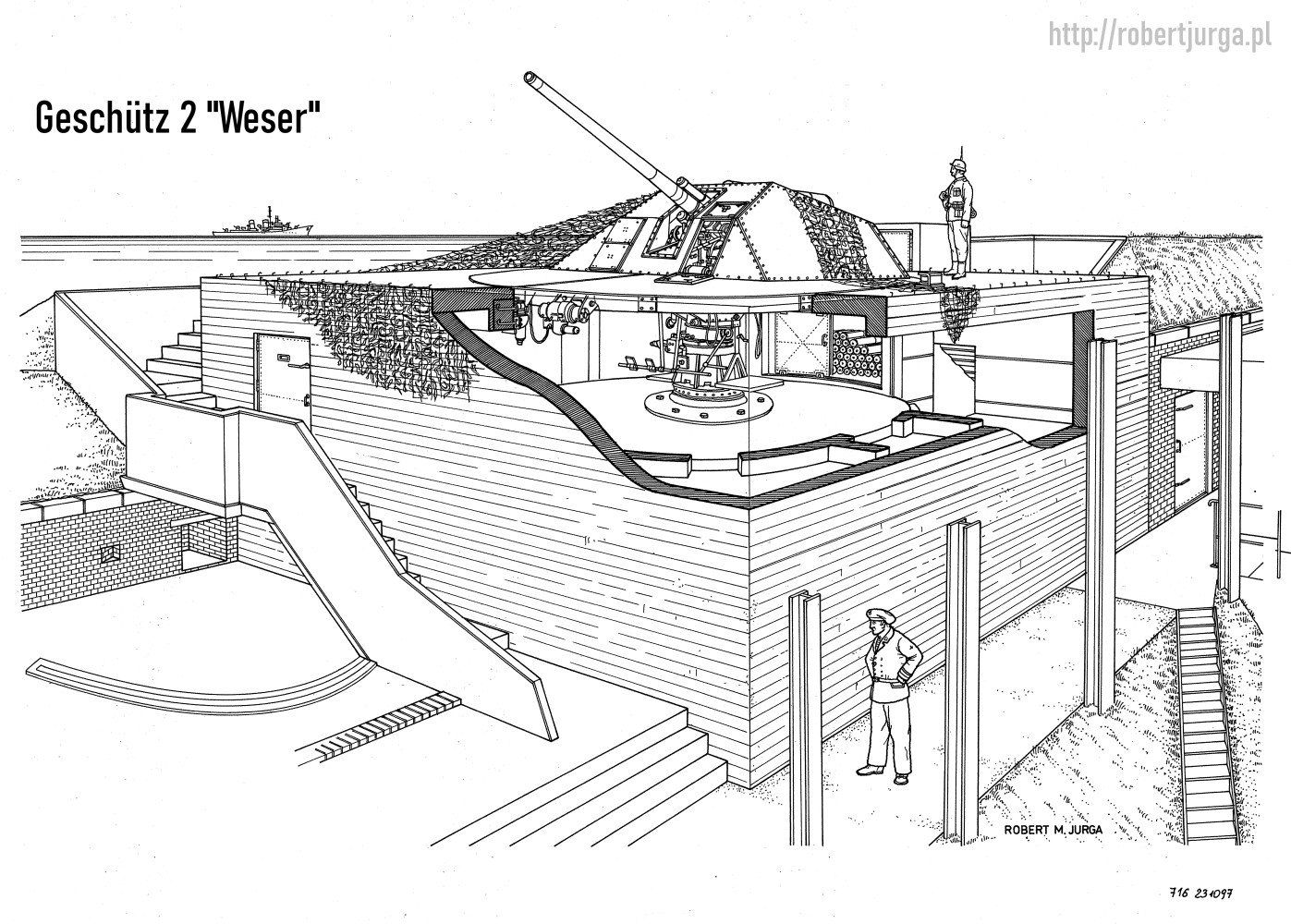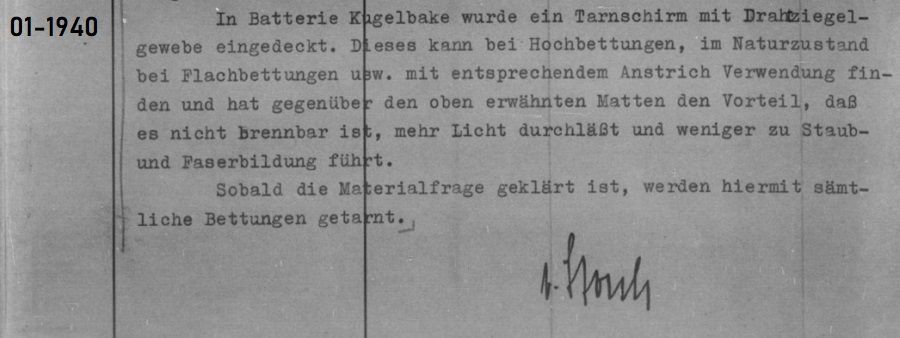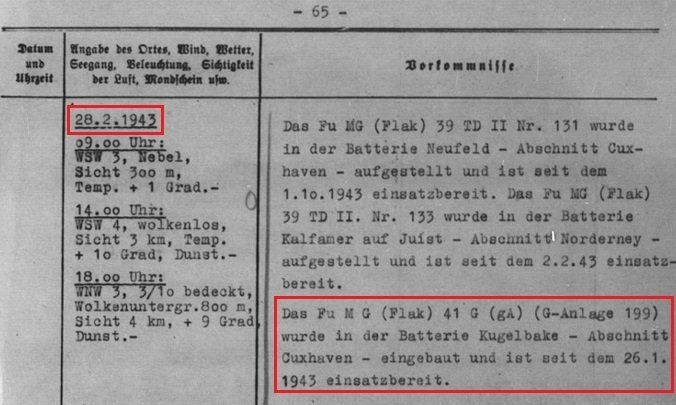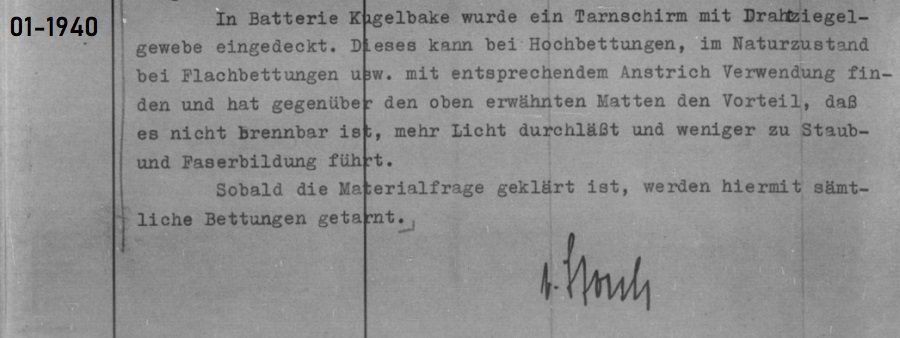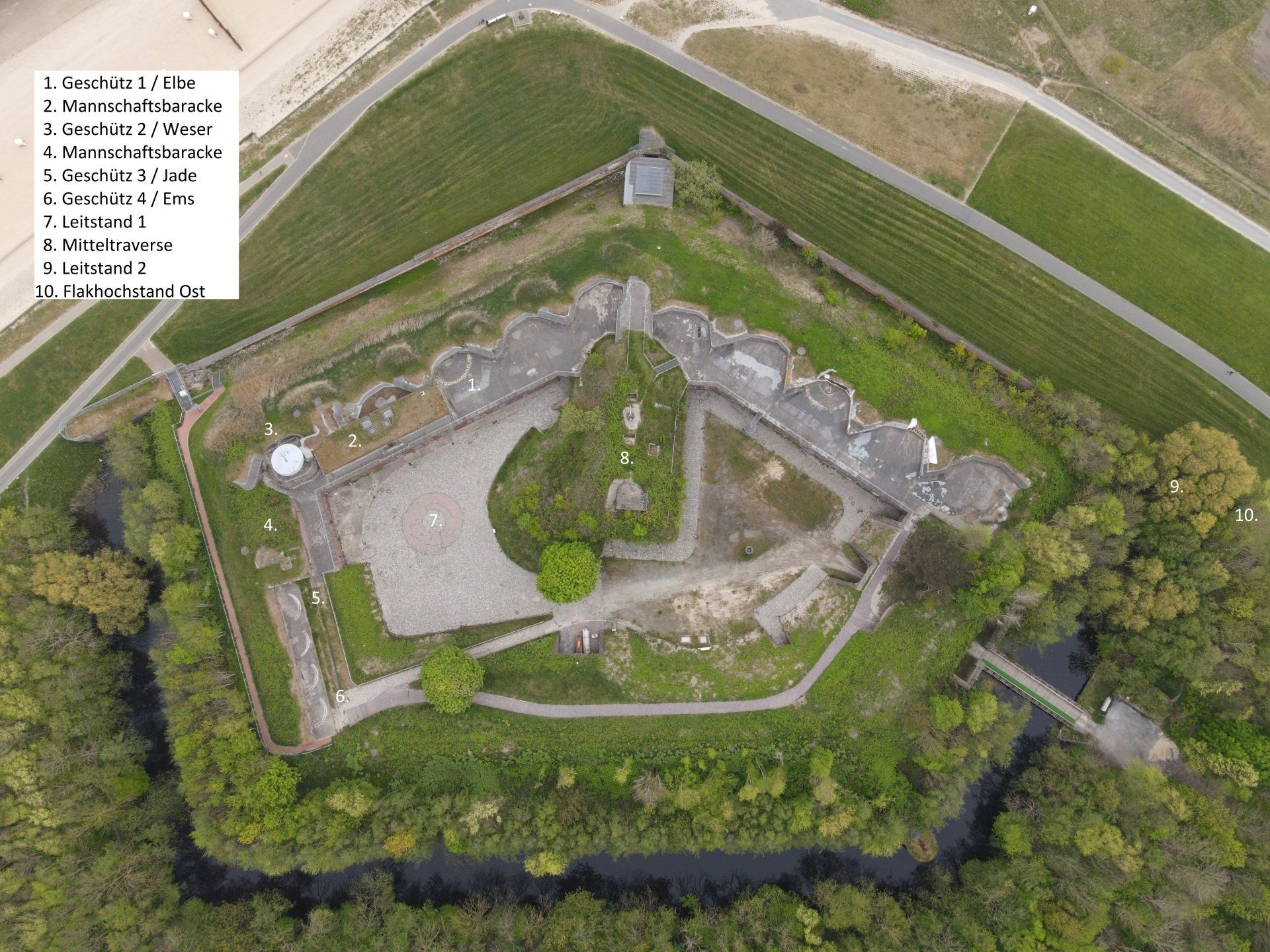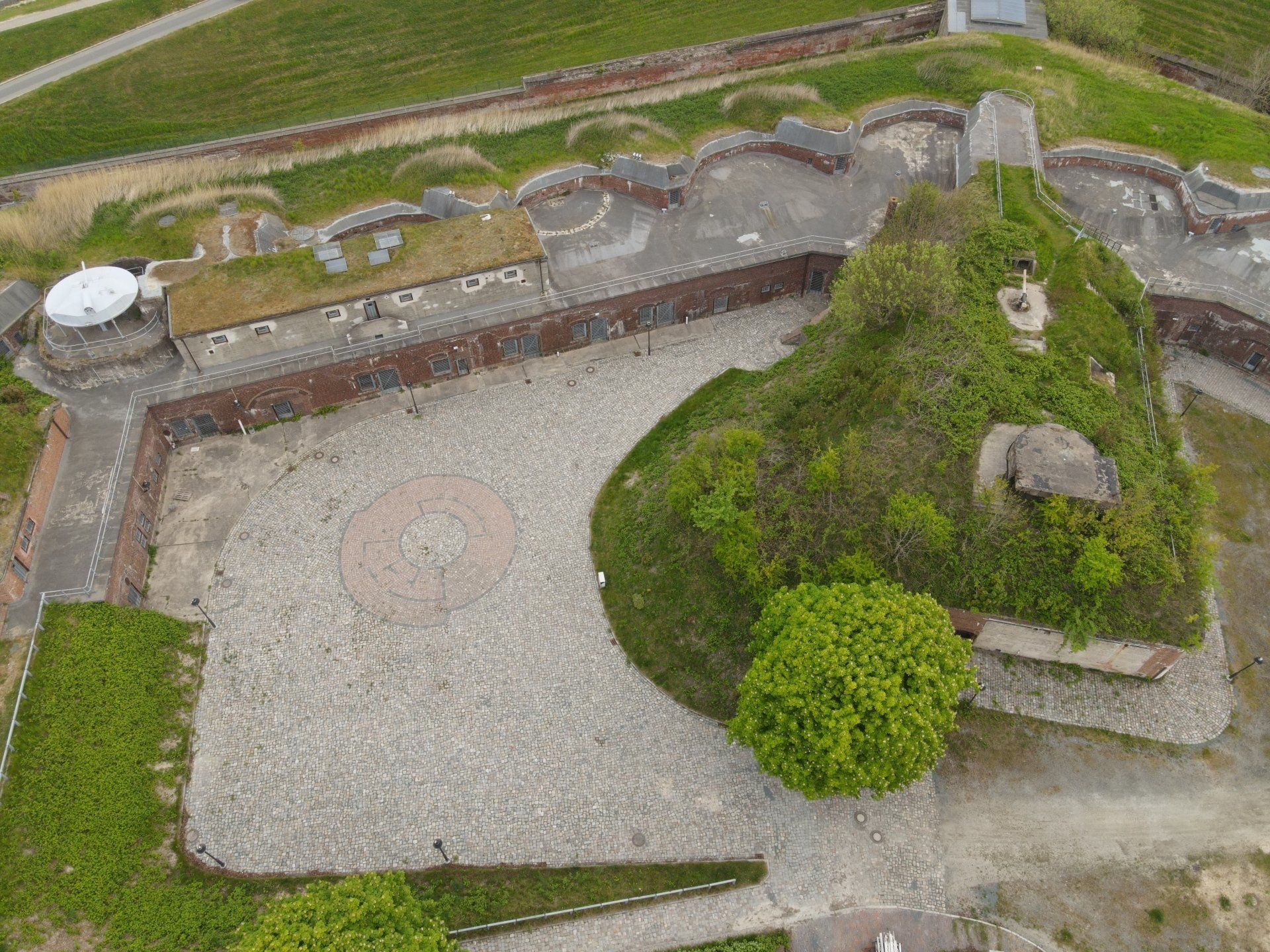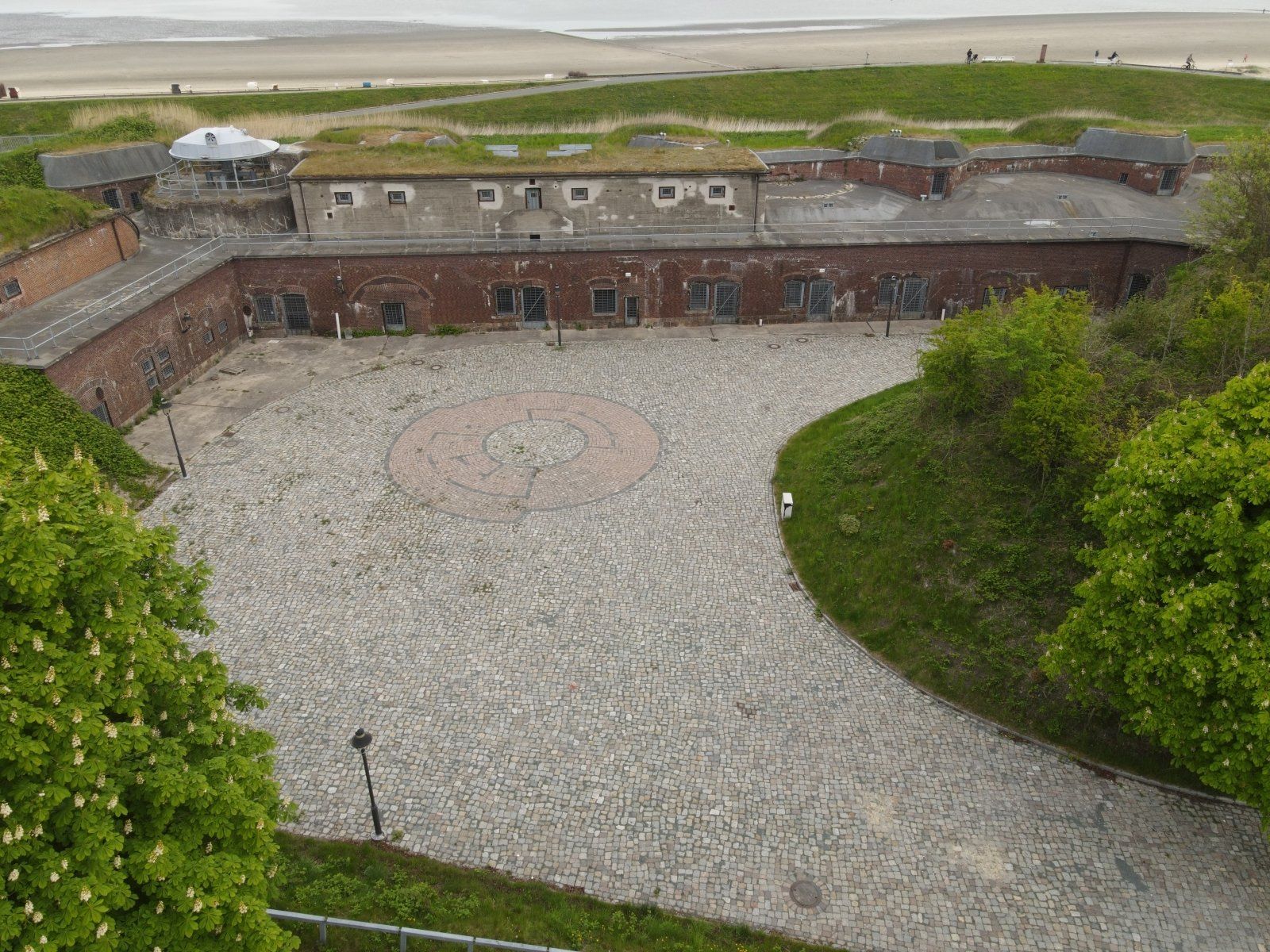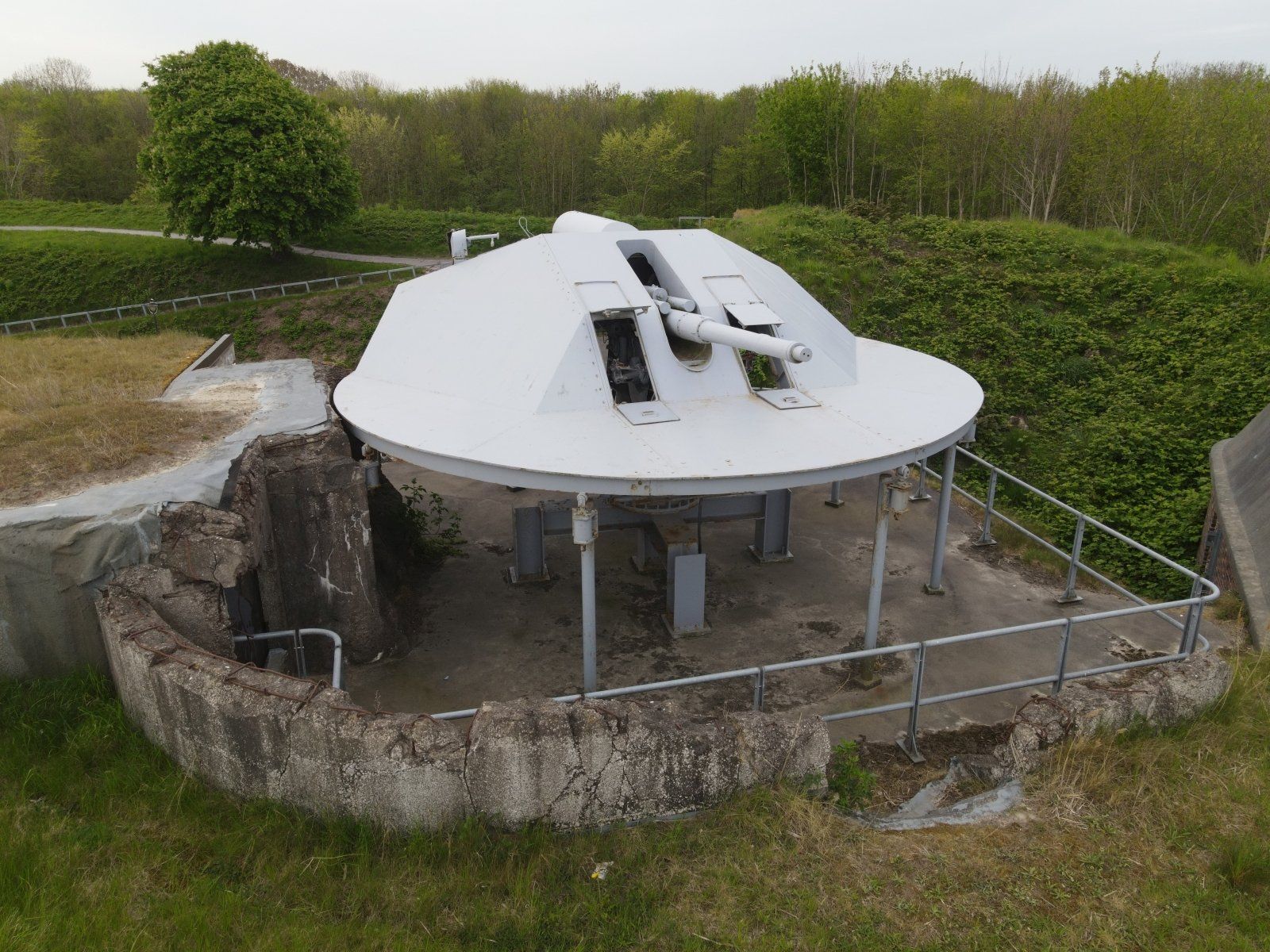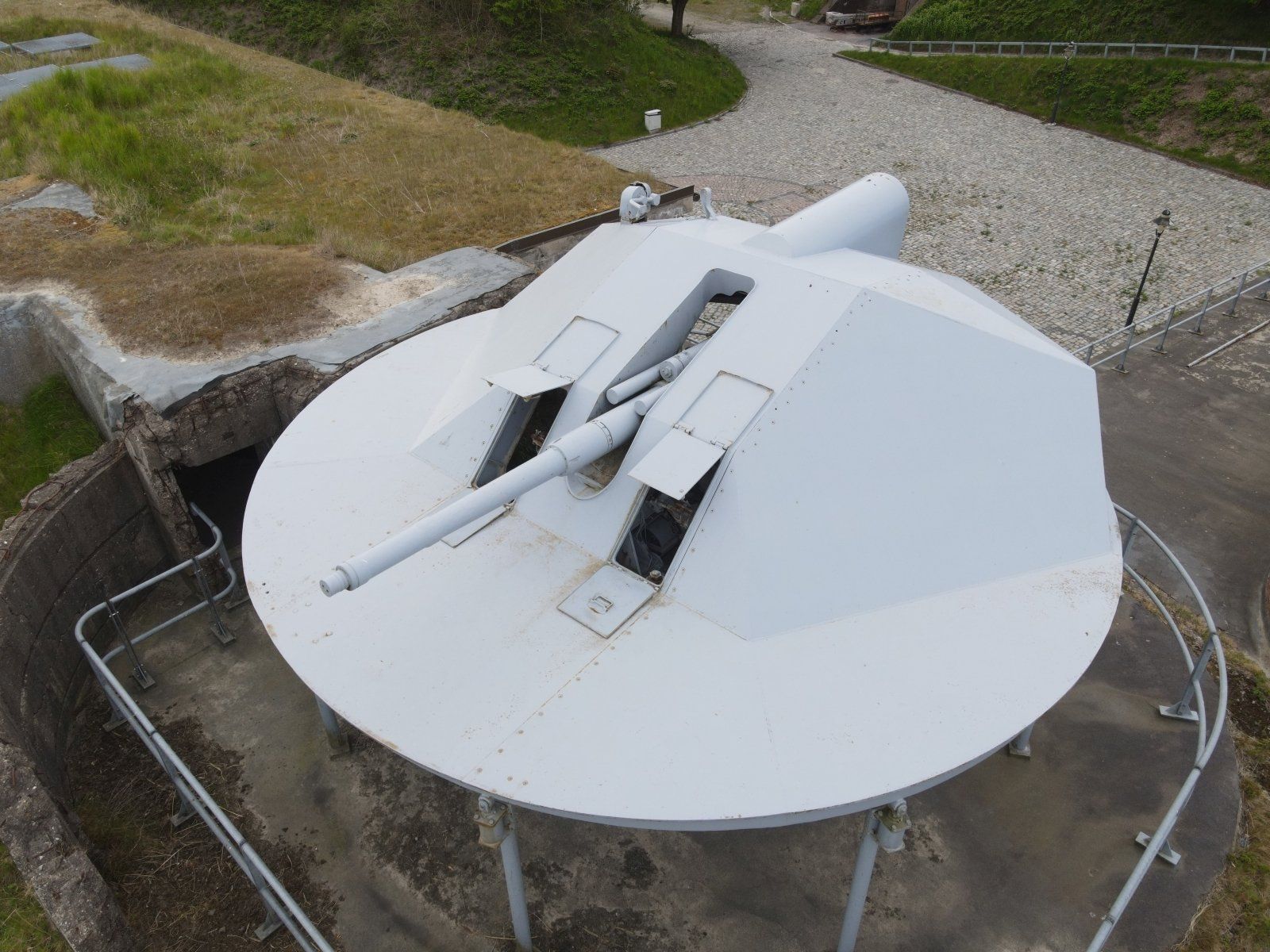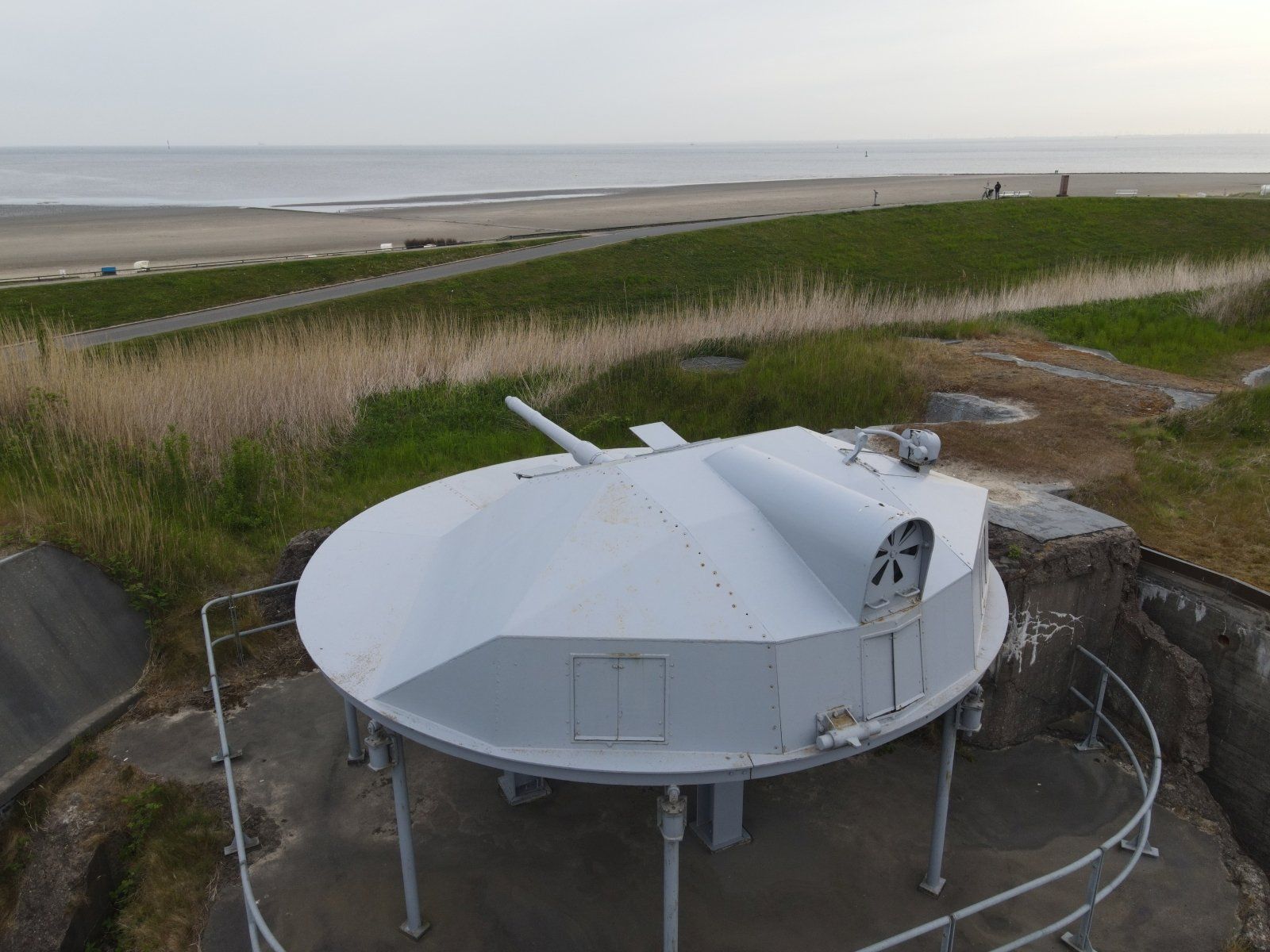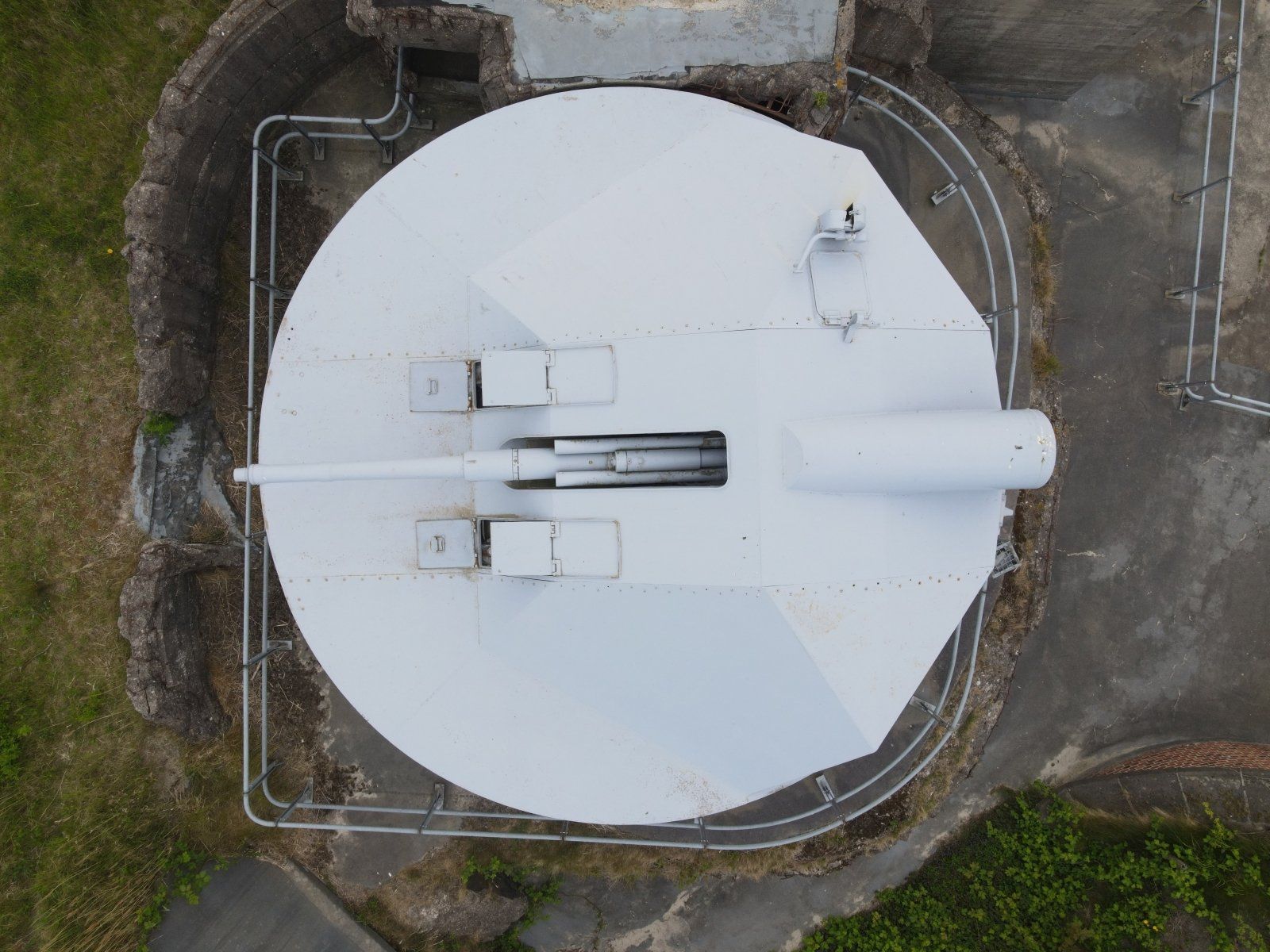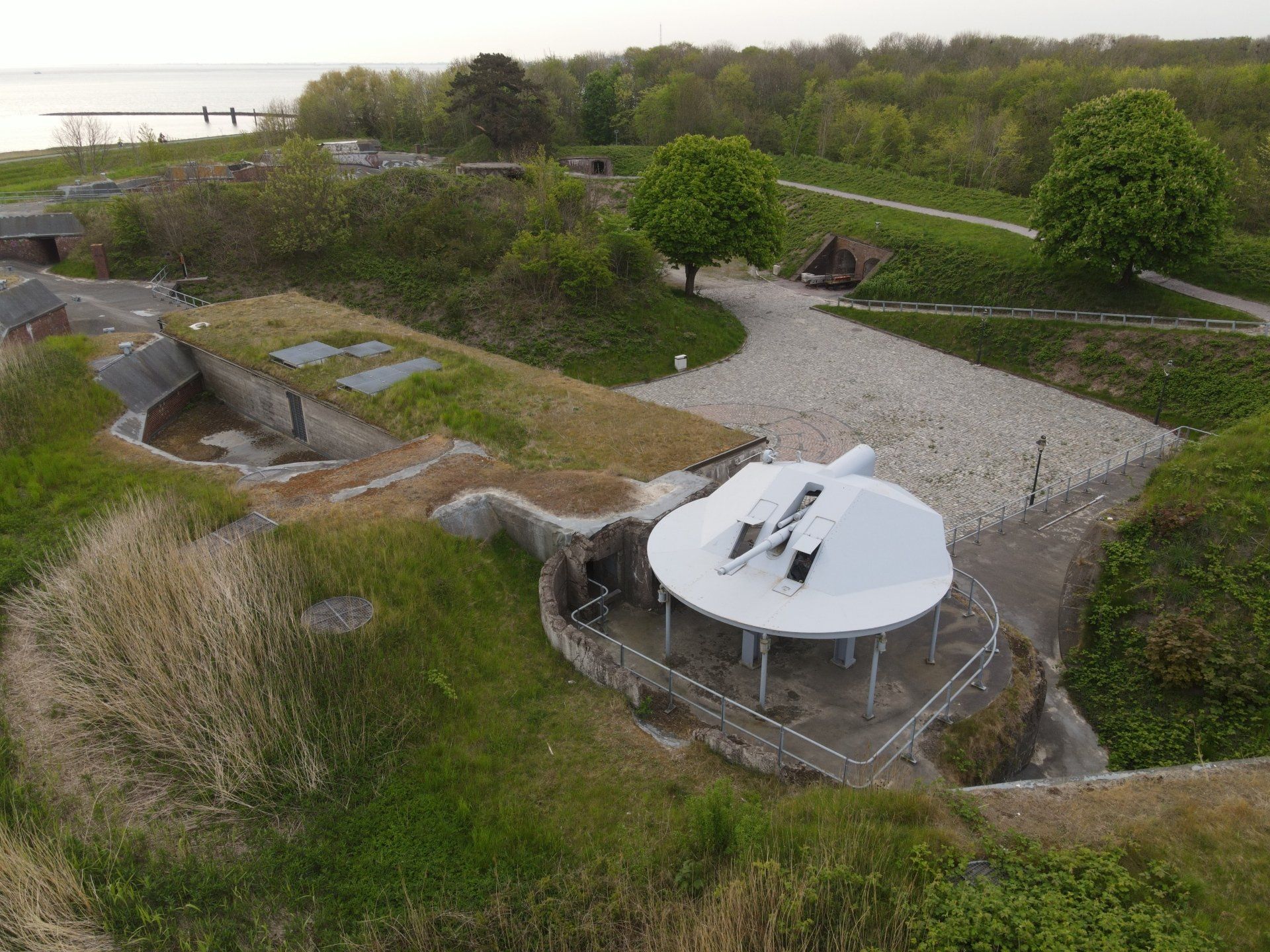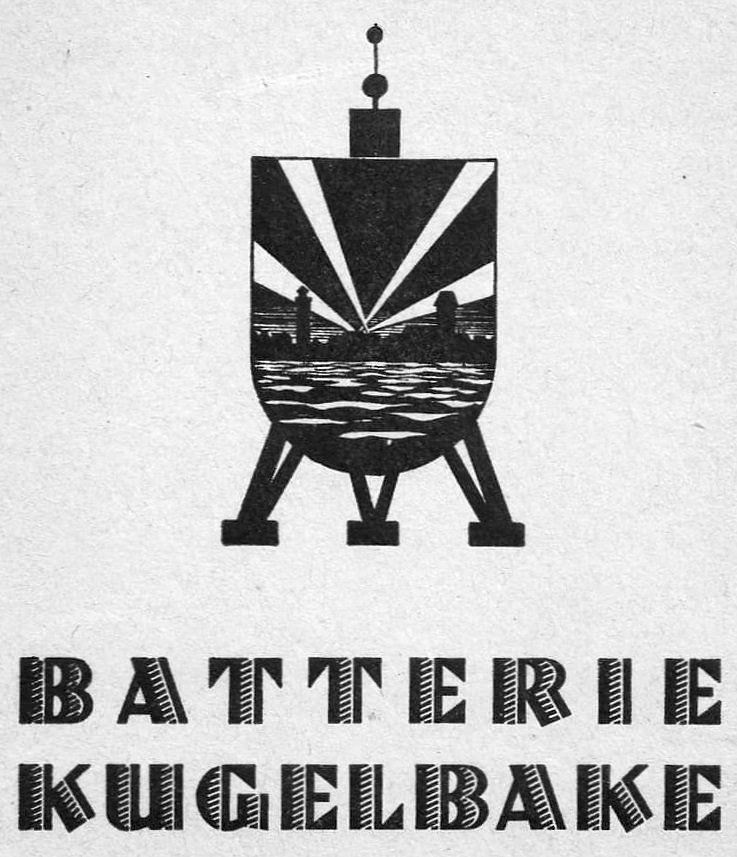

In contrast to the other four Cuxhaven anti-aircraft positions, the Kugelbake battery had a different significance. It was not built in the open countryside but was instead located in the former Kugelbake naval fort. After the First World War, the entire facility was disarmed and served for a few years only as an ammunition depot. From 1920 onwards, the fortress was finally abandoned. There was talk of the entire complex being demolished in order to expand the adjacent spa gardens, but this never happened. From 1931 onwards, the Reichsmarine began to renovate the former fort. On August 27th, 1939, the 1st/Marine Anti-Aircraft Division 214 of the Cuxhaven Anti-Aircraft Command was set up and moved into Fort Kugelbake. Extensive construction work had already been carried out beforehand to arm and operate an anti-aircraft position. In addition, several functional buildings were built in and around the naval fort. On the western flank, two raised bases were built for the 8.8 cm guns (probably model 39 in the beginning), as were two more on the northwest side of the cube traverse. Between these two bases, a cast-in-concrete crew quarters for guns 1 and 2 were built. The second crew quarters were built between guns 2 and 3; both buildings are still standing today. In the western courtyard, a round fire control tower was built that towered above the height of the fortress. It contained command post 1 and, on top of it, the three-car. On the dyke to the east above the fort, a raised stand was built on which a light 2 cm anti-aircraft gun MG C/30(L) was mounted. Fire control post 2 was also built here, on which the Fumo 201/202 was later installed. During air raid warnings, civilians from the immediate vicinity of the fort sometimes came to the complex to find shelter from bombs in the casemates.
Die Kompaniechefs der Batterie Kugelbake von 1939 - Ende 1940
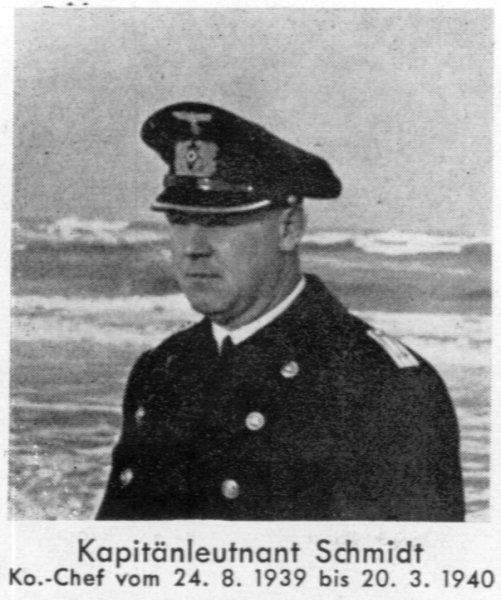
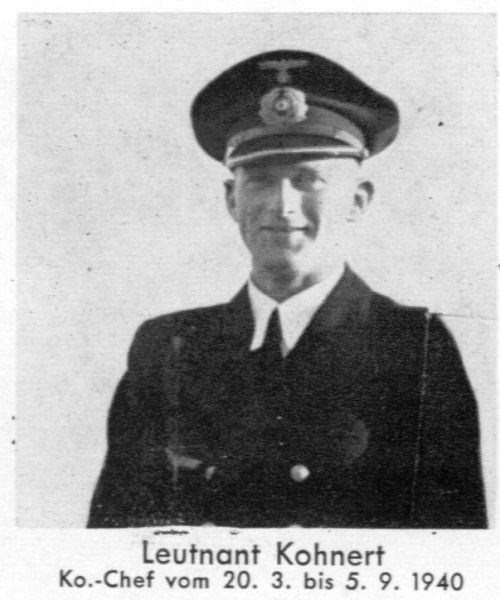
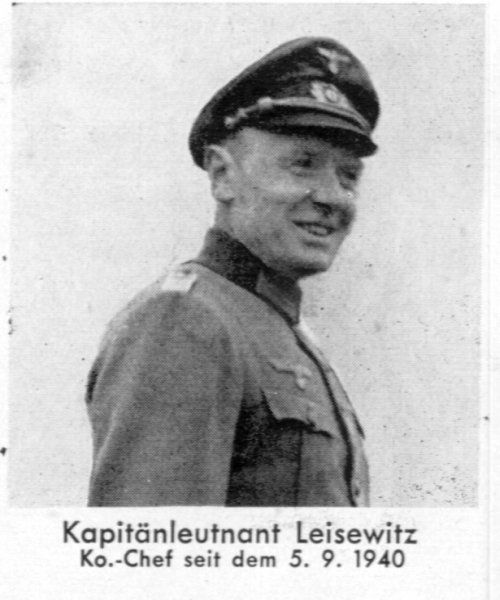
Photo source: Chronicle of the Kugelbake Battery 1940
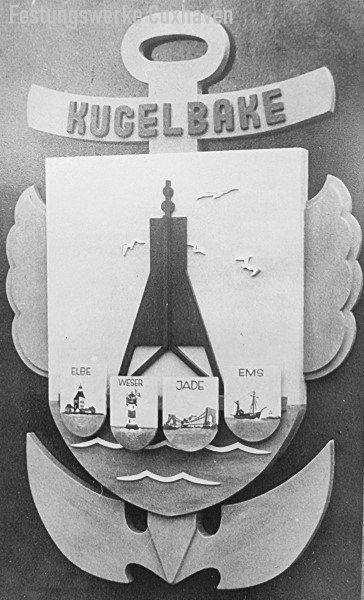
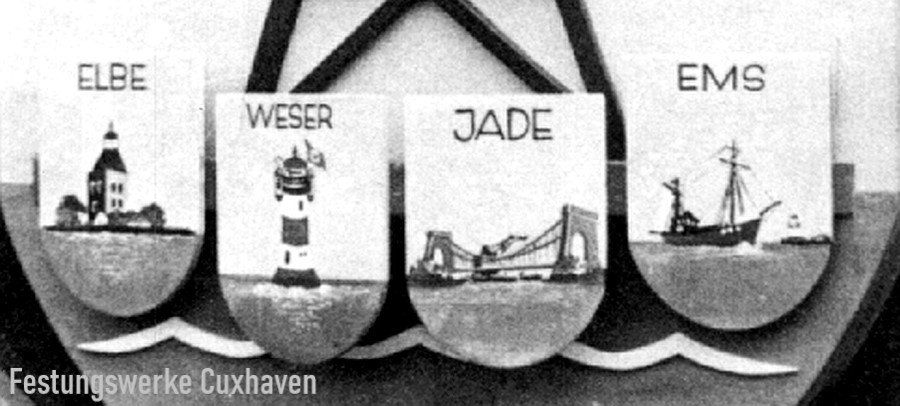
Das Wappen der Batterie Kugelbake mit den Namen der vier schweren Flakgeschütze, Elbe, Weser, Jade und Ems. Es hing seinerzeit über dem Torbogen am Eingang hinter der Brücke.
Quelle: Stadtarchiv/Gerd Wildfang
Just a few days after the war began, the Kugelbake battery was able to report its first kill on September 4, 1940. In one of the first air raids by the Royal Air Force on the German Reich, British Vicker Wellington bombers attacked the locks at Brunsbüttel. Here they discovered the two German battleships Scharnhorst and Gneisenau, which they attacked as their primary target, but without causing any damage. During the battle, two aircraft were shot down on site, the rest headed off across the Elbe towards the sea. The war report below reports on the sudden appearance of the bombers and the battle off Cuxhaven.
Although the war raged on many fronts in the first few months, the territory of the Reich at that time remained relatively quiet. Although the air forces of the British and their Commonwealth allies were omnipresent, especially at night, Cuxhaven remained relatively peaceful at that time, apart from a few bombings. But this deceptive appearance was to change quickly as time went on. While the Kugelbake battery had 356 pure naval artillerymen at Christmas 1940, it fell significantly as the war progressed. The reasons for this were losses on all fronts and above all at sea. In addition, the coastal areas in France, Flanders, the Netherlands, Denmark, on the Scandinavian coasts, the Black Sea and the Aegean had to be defended by naval forces. All of this consumed a huge amount of personnel, which somehow had to be replaced in order to be able to operate a heavy anti-aircraft position effectively.
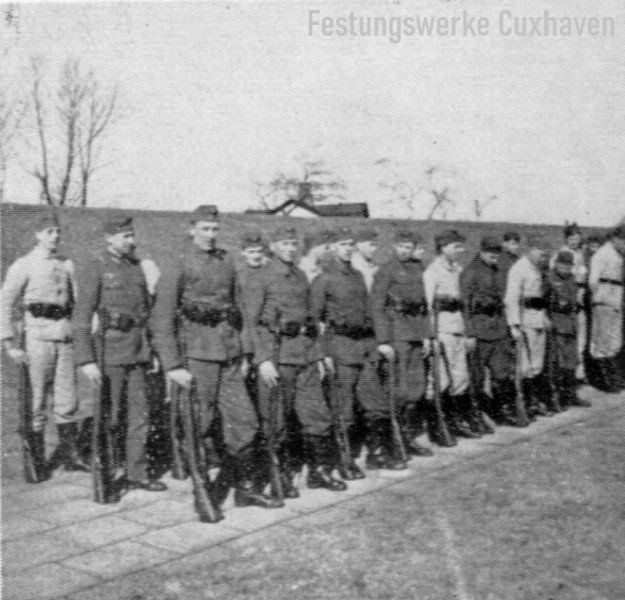
Infantry service in front of the dike, in the background the battery's operating buildings in front of the entrance to the fort. Photo source: Chronicle of the Kugelbake Battery 1940
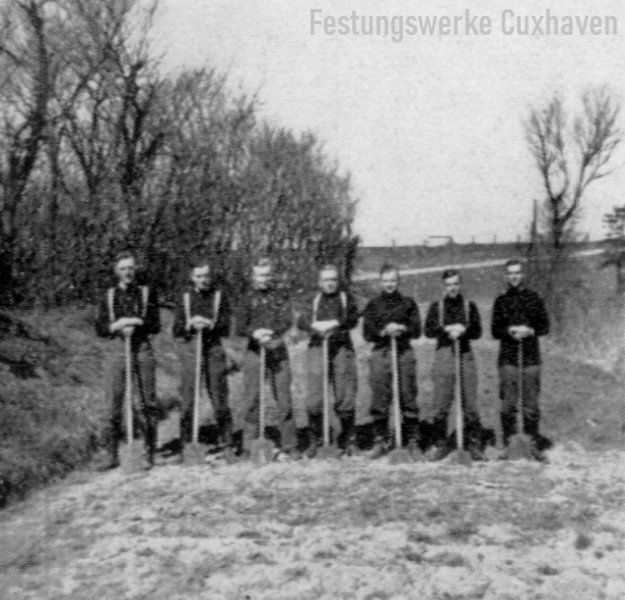
Community work in the garden on the west side of the moat to Strandstrasse. In the background the dyke ramp to the Strandhalle restaurant. Photo source: Chronicle of the Kugelbake Battery 1940
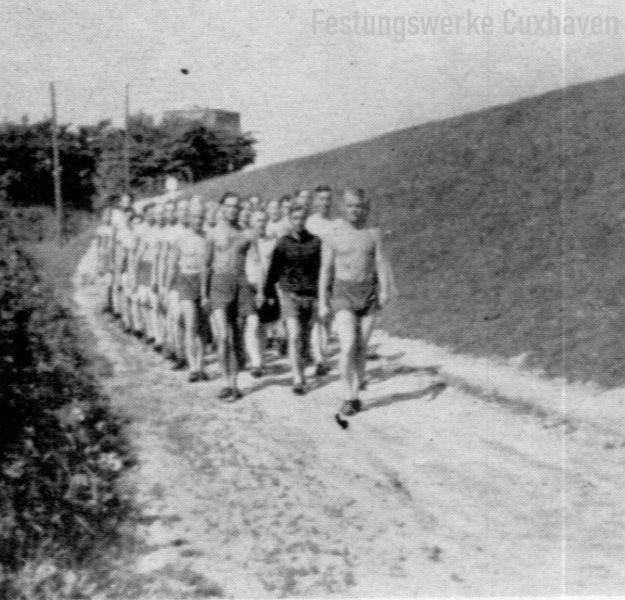
On the way to the sport in front of the Döser Seedeich. On the left are the moor meadows, in the background the anti-aircraft high stand on the dike. Photo source: Chronicle of the Kugelbake Battery 1940
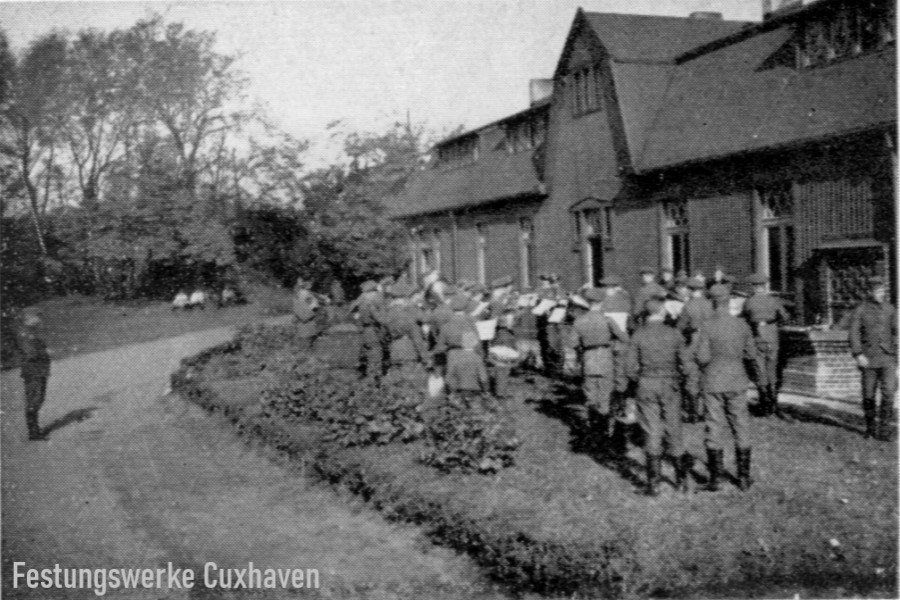
The staff barracks built in 1913 outside the battery, in the background the entrance to Fort Kugelbake. Although it did not look like it, according to contemporary witnesses it was only a wooden building. Photo source: Chronicle of the Kugelbake Battery 1940
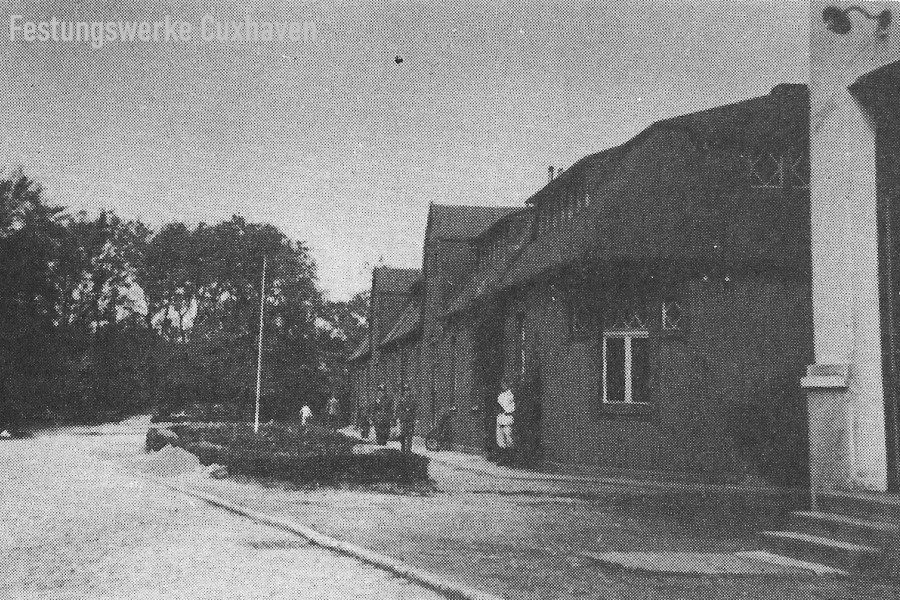
The light building on the right, however, was made of brick and plaster. This was the former railway house (before that the Wallmeisterhaus). It was built shortly after the turn of the century around 1900. The building was not used by the army in WWII; a family lived on the ground floor. Source: Gerd Wildfang
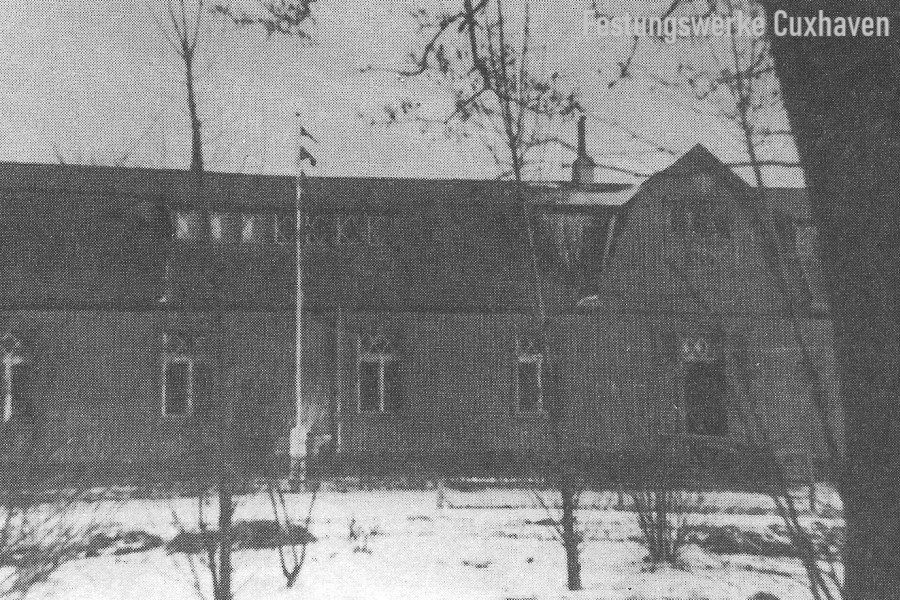
The roll call area in front of the staff barracks.
Photo source: Marine helper in the Kugelbake battery / 1995
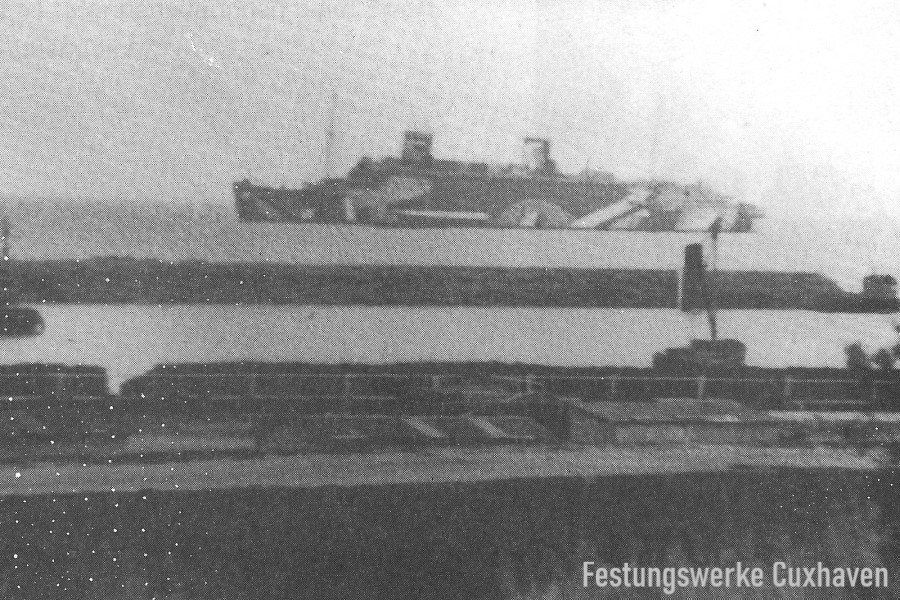
Auf dem Foto das 1929 gebaute Fahrgastschiff Bremen. Vermutlich kommt sie gerade mit einem neuen Tarnanstrich aus Hamburg und ist auf dem Weg nach Bremerhaven. Dort lag sie dann als Wohnschiff, bevor sie am 16.03.1941 auf Grund eines Feuers an Bord fast komplett ausbrannte.
Photo source: Marine helper in the Kugelbake battery / 1995
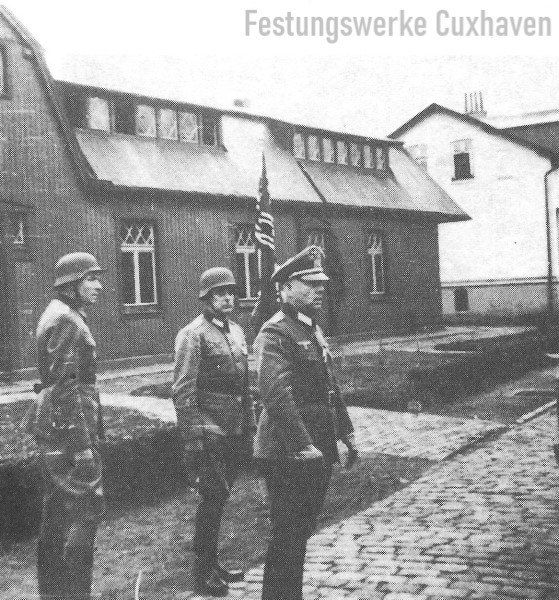
Department Commander Korv.-Kapitän Prinz von Hohenzollern Emden handing over a launch pennant to the Kugelbake battery. Photo source: Marinehelfer in the Kugelbake battery / 1995
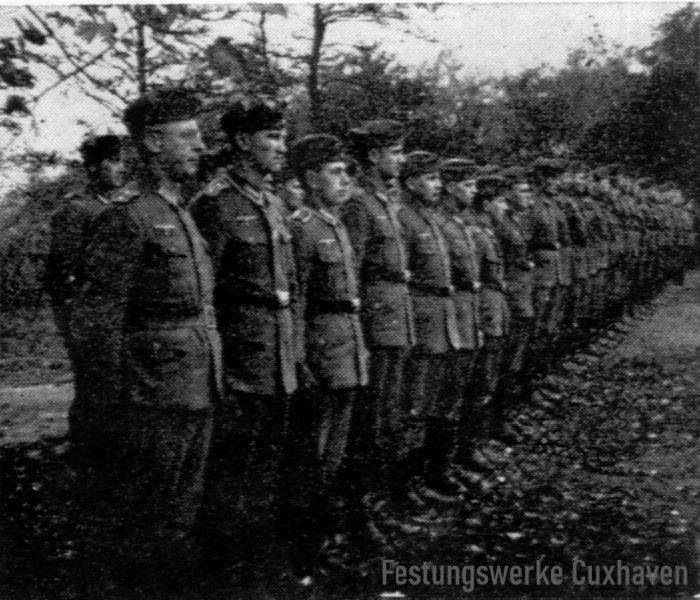
The naval artillerymen of the 1st Company lined up (1940). Photo source: Chronicle of the Kugelbake Battery 1940
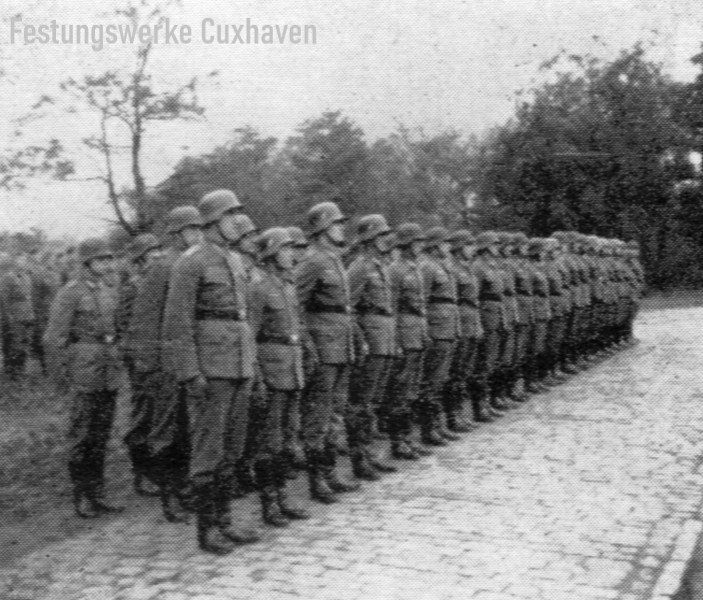
Marines of the Kugelbake Battery (1941) enlisted.
Photo source: Marine helper in the Kugelbake battery / 1995
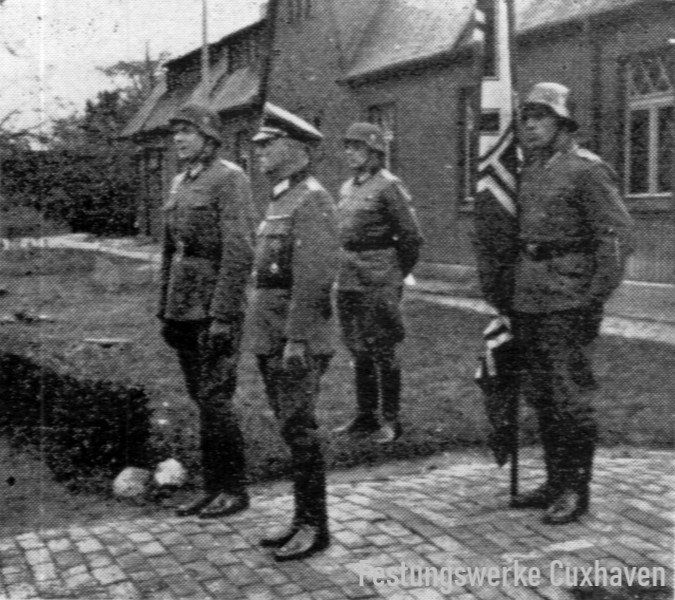
The company commander, Kpltlt. Leisewitz (left) speaks to the crew. In the foreground, the division commander, Korv.-Kapitän Prinz von Hohenzollern Emden.Photo source: Marinehelfer in the Kugelbake battery / 1995
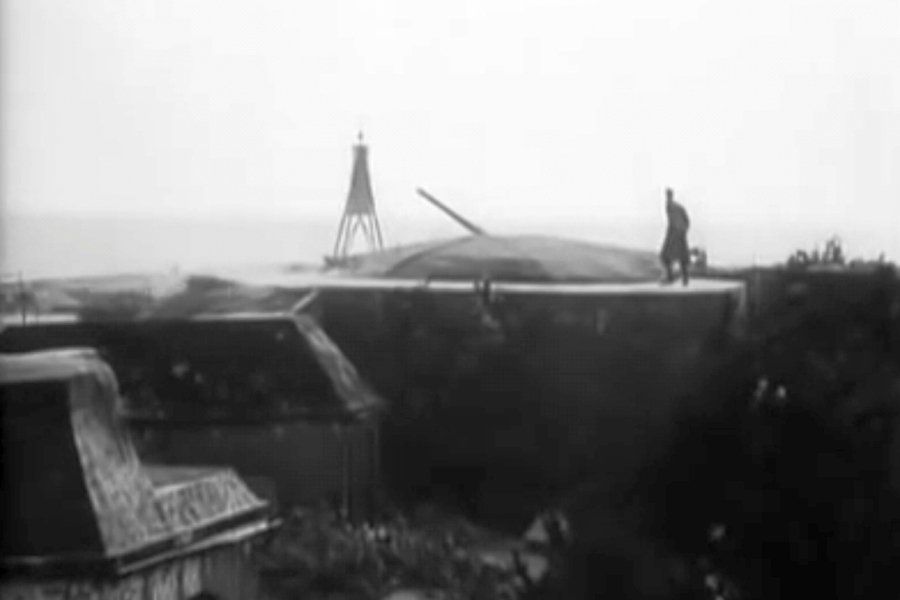
An 8.8 cm anti-aircraft gun, probably on the position of the later gun 1 - Elbe. Behind it the central traverse. (1940)
Fotoquelle: N.N.
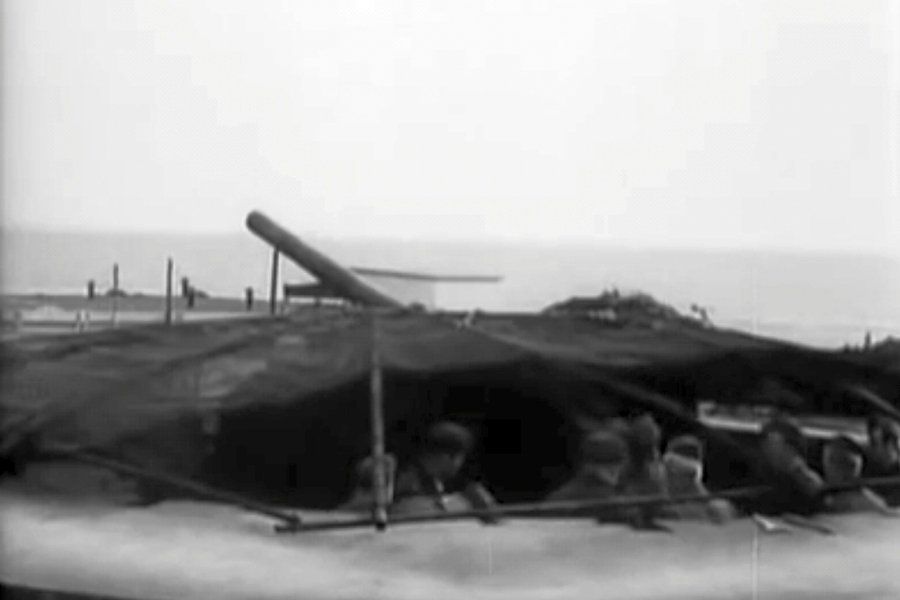
The 8.8 cm. naval guns of the time were not yet equipped with a protective cover against fire and splinters. Above them there was only a metal frame covered with camouflage nets. (1940)Photo source: NN
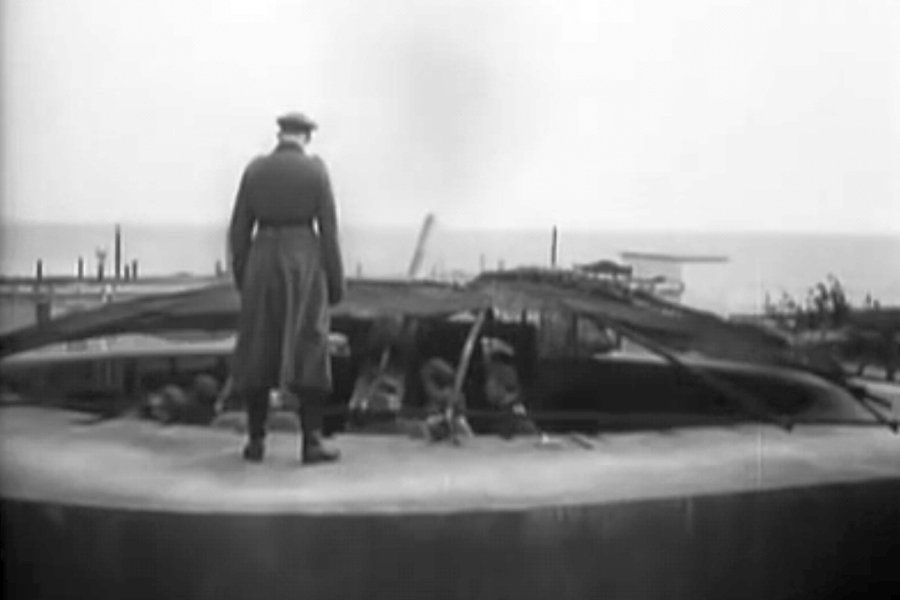
Under the camouflage net you can see that the gun was equipped with a frontal protective shield.
Fotoquelle: N.N.
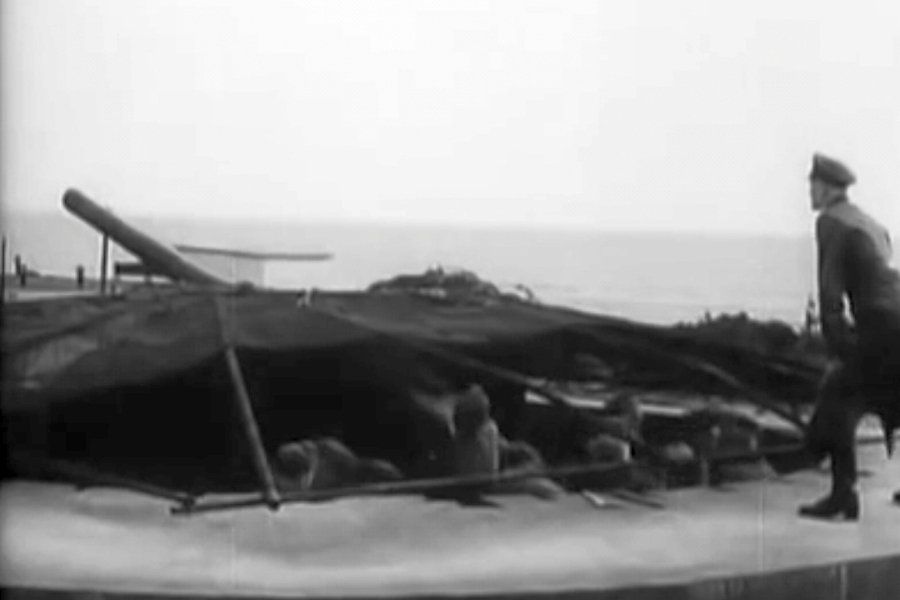
The building in the background is the roof of the former Döser Strandhalle, which stood there until the 1980s.Photo source: NN
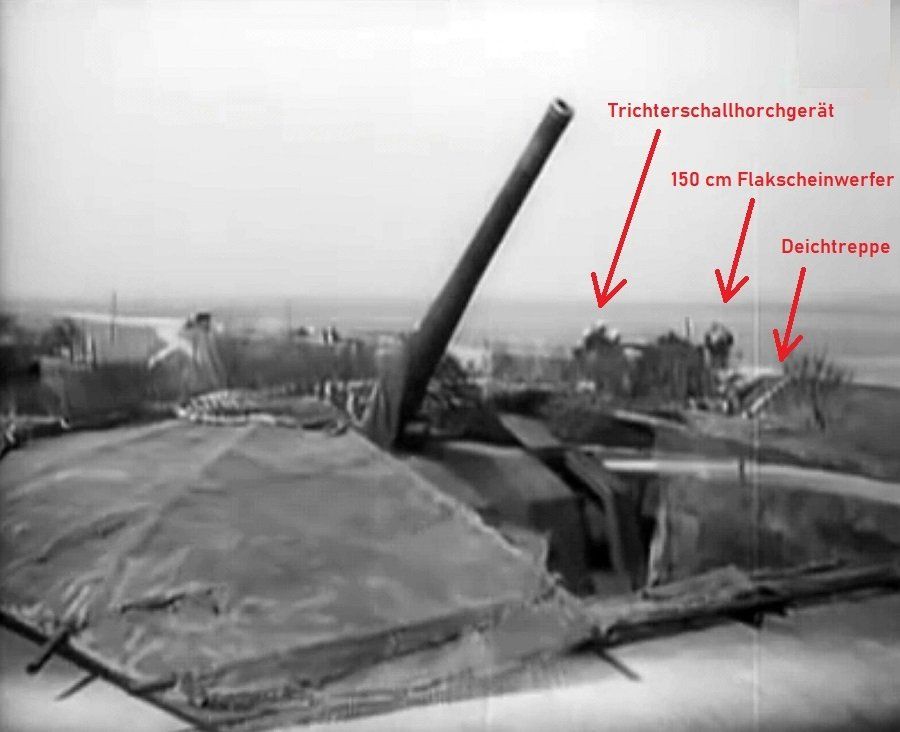
The photo has now been assigned to the Kugelbake battery. The anti-aircraft gun shown is on the site of the later 10.5 cm gun 2 "Weser" on the northwest side of the fort. Behind it is the invisible moat and the beach road (Döse). To the front you can see the dyke with the steps, in the background the Wadden Sea. To the left of it is the 150 cm anti-aircraft searchlight and the funnel sound listening device. It has not yet been possible to determine whether the gun shown was an 8.8 cm or 10.5 cm.
Fotoquelle: N.N.
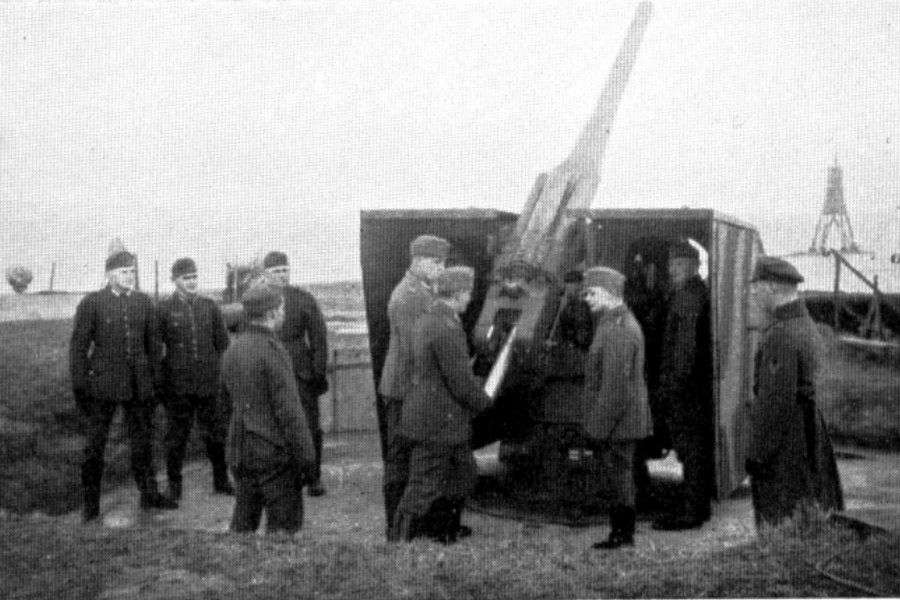
Photo of another 8.8 cm gun from the battery between 1939 and 1941, but from a different source. The exact location has not yet been researched. However, it is located quite far on the northeast side of Fort Kugelbake. It may also have been on the central traverse. Photo source: Gerd Wildfang.
A short film excerpt from a German newsreel from 1940.
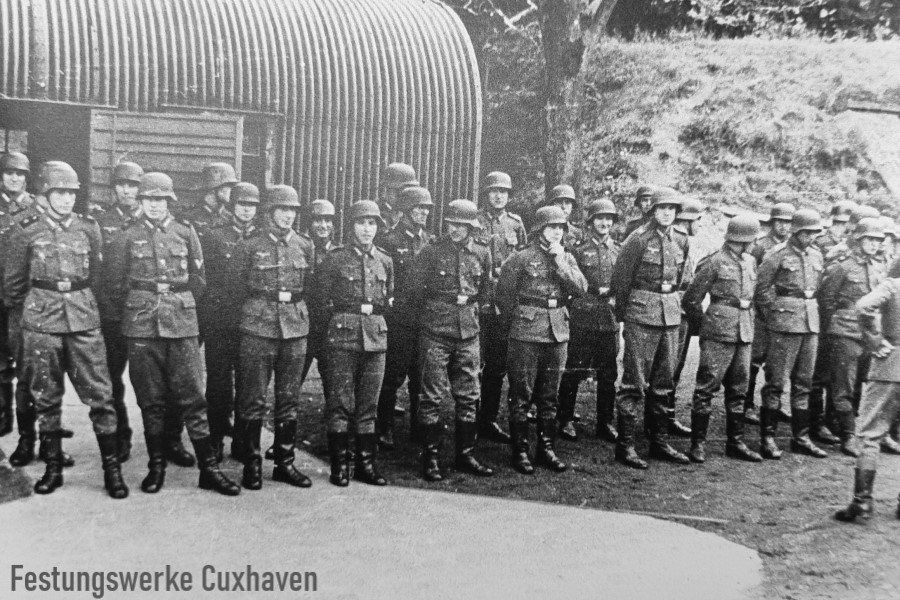
Lined up in front of the rear "Kehlwall", behind it the moat. On the left a corrugated iron barrack.Source: City Archives/Gerd Wildfang
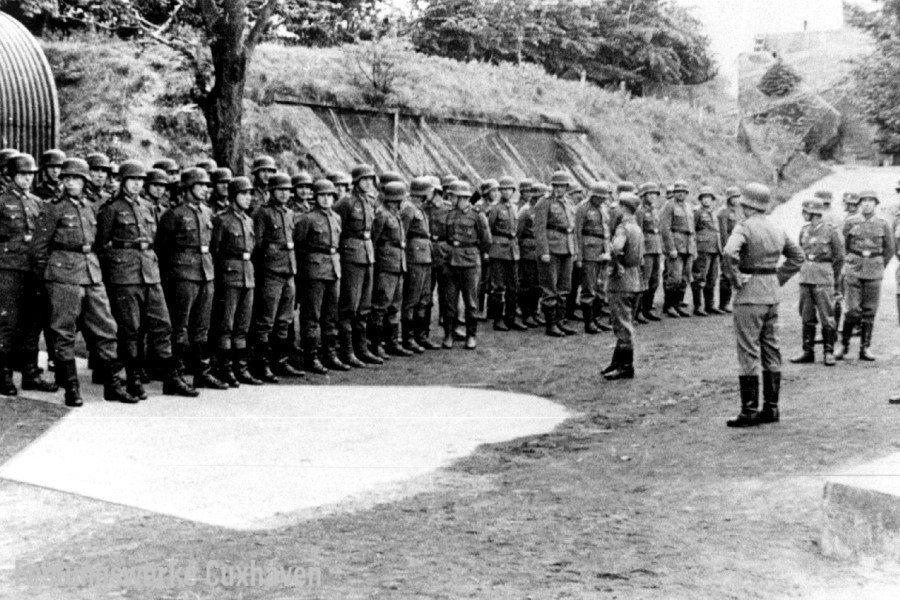
On the right is the ramp to the base of gun No. 4 "Ems". Source: City Archives/Gerd Wildfang
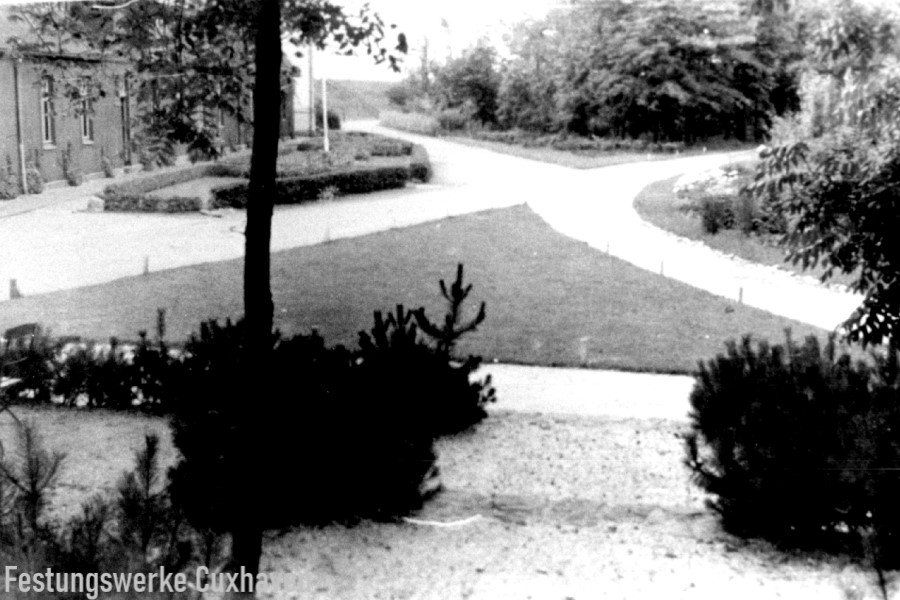
The roll call area in front of the staff barracks.Source: City Archives/Gerd Wildfang
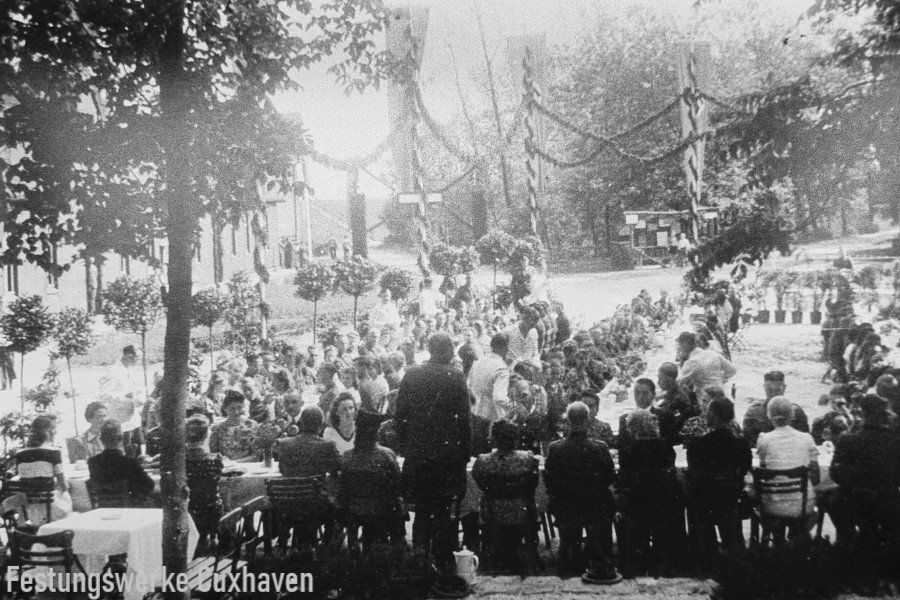
Battery Festival 1942 with family members and friendsSource: City Archives/Gerd Wildfang
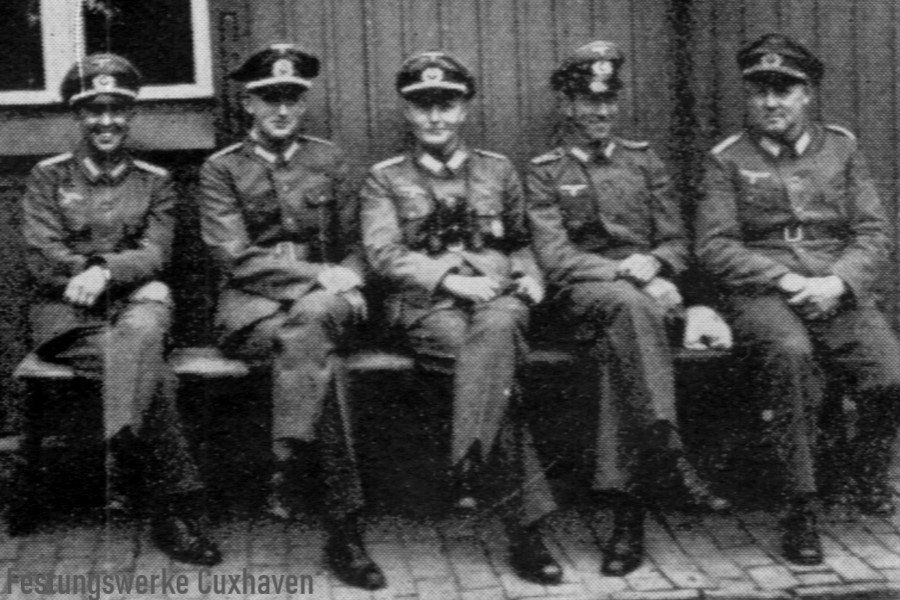
Leaders in front of the staff barracks. From left: Assistant Doctor Dr. Laufer, Lt. Kohnert, Oblt. Nebelsiek, Fw. Huisgen, Kptlt. Schmidt. Photo source: Chronicle of the Kugelbake Battery 1940
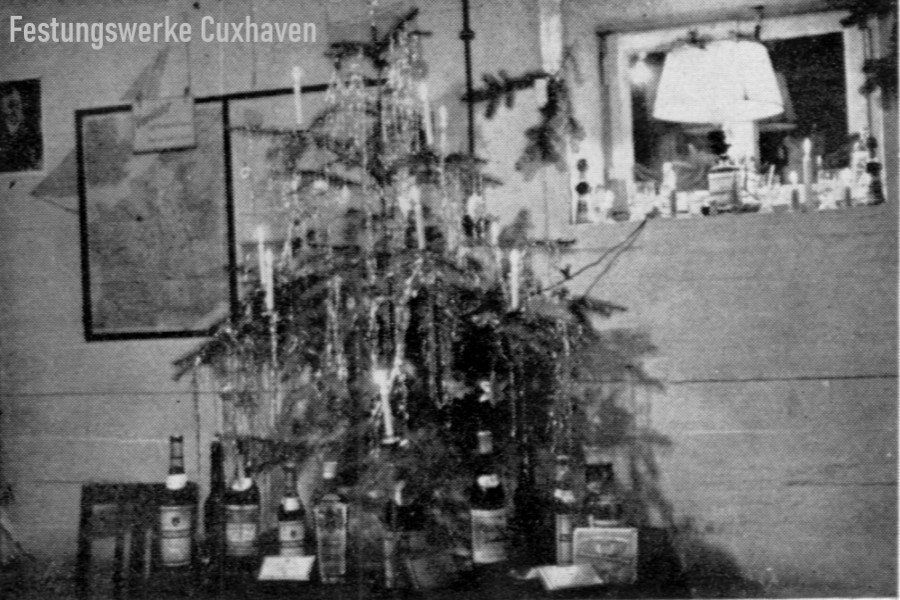
Wartime Christmas 1940 in the barracks. Photo source: Chronicle of the Kugelbake Battery 1940
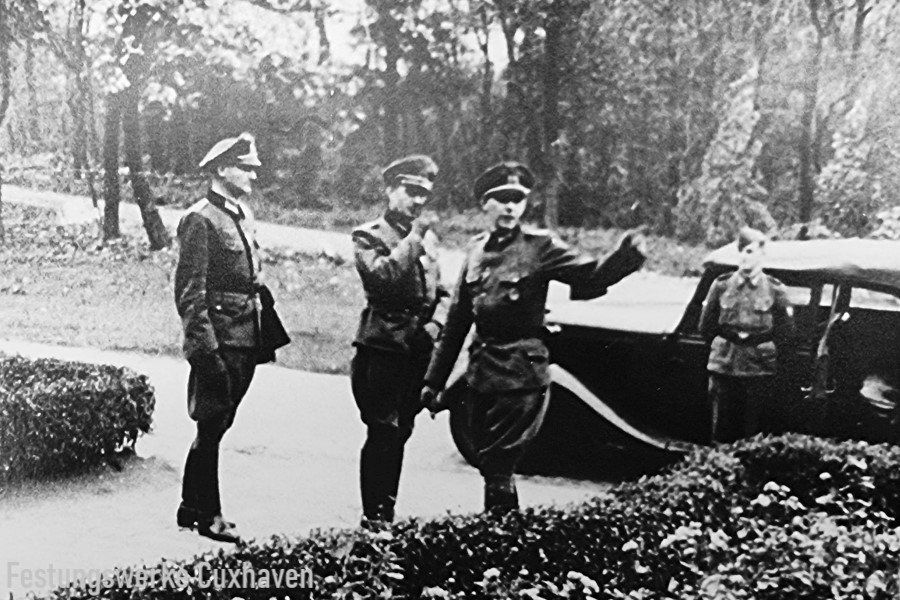
The battery commander of the "Kugelbake" position with his colleague Captain Brune from the "Stand Heide" battery in Duhnen.Source: City Archives/Gerd Wildfang
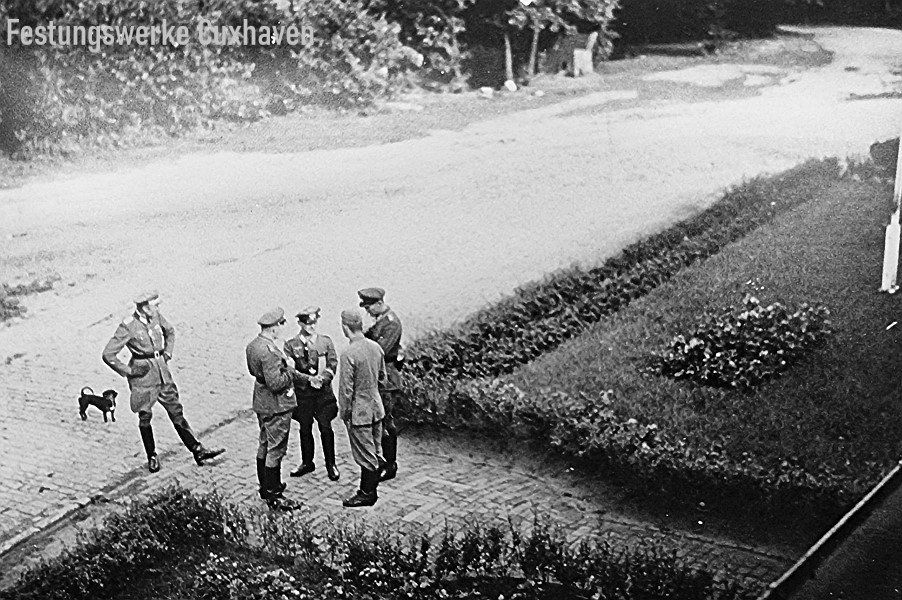
Managers in front of the staff barracks.Source: City Archives/Gerd Wildfang
Marine helpers in the Kugelbake battery
Just a few days after the end of the discharges in 1943, the male students from the high schools were distributed to the various anti-aircraft batteries in the city of Cuxhaven. Their job was to support the soldiers at the guns and other equipment as naval anti-aircraft assistants in the positions according to their abilities. In this case, accompanied by military music, they walked from the schools to Fort Kugelbake, where they were greeted by the company commander and the sergeant. After a few days in temporary quarters, the young people moved into the naval barracks below control center 2. They were dressed in a blue naval uniform and overalls for work. After that, training on the various guns, searchlights, measuring devices, ignition devices and ammunition began immediately. Here, mathematics was a key factor in calculating trajectories, lead angles and ballistics. Gun drills were also reinforced to ensure that the battery's salvos could be fired in quick succession. Only 5 seconds were available for this. As mentioned, in 1940 there were 356 naval artillerymen, but by the beginning of 1943 the number of regular crew members had dropped to just 49. There were also 40 naval assistants, 16 naval assistants and 25 Russian troops, making a total of 81 battery personnel in the Kugelbake position. Later in the war, naval assistants from the towns of Stendal, Duderstadt, Oschersleben and Tangermünde came to the Kugelbake battery to do their duty there.- Report by a naval assistant from the Kugelbake battery on the air raid on the town of Cuxhaven on 11 June 1943.Source: Harald Schünemann, Gerd Wildfang
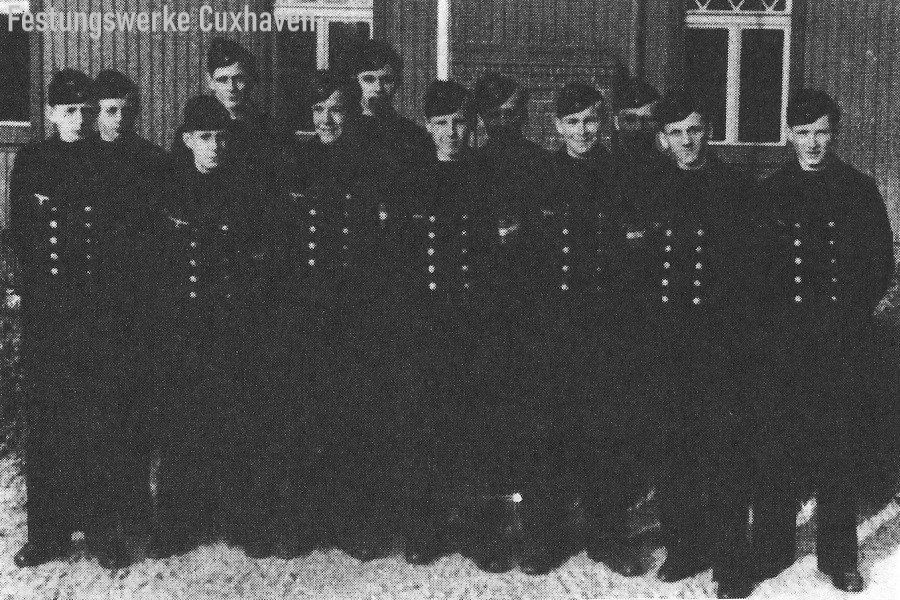
Marine helpers from the Kugelbake battery in front of the staff barracks. They were mainly minors between the ages of 15 and 17 from Cuxhaven's high schools and secondary schools. Today they would be called child soldiers. Photo source: Marine helpers in the Kugelbake battery / 1995
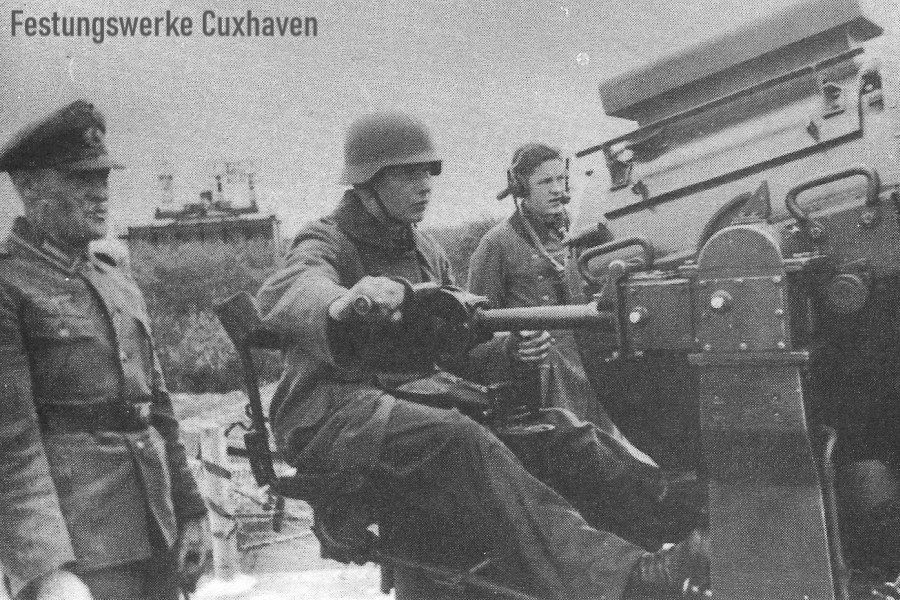
Ofw.Schünemann, MH.Steffens und MH.Kröncke. Ausbildung am G90 Flakscheinwerfer (90 cm Spiegeldurchmesser) auf dem Batteriewall rechts über dem Eingangstunnel. Im Hintergrund der Leitstand 2.
Fotoquelle: Marinehelfer in der Batterie Kugelbake / 1995
Russian forces in the Kugelbake battery
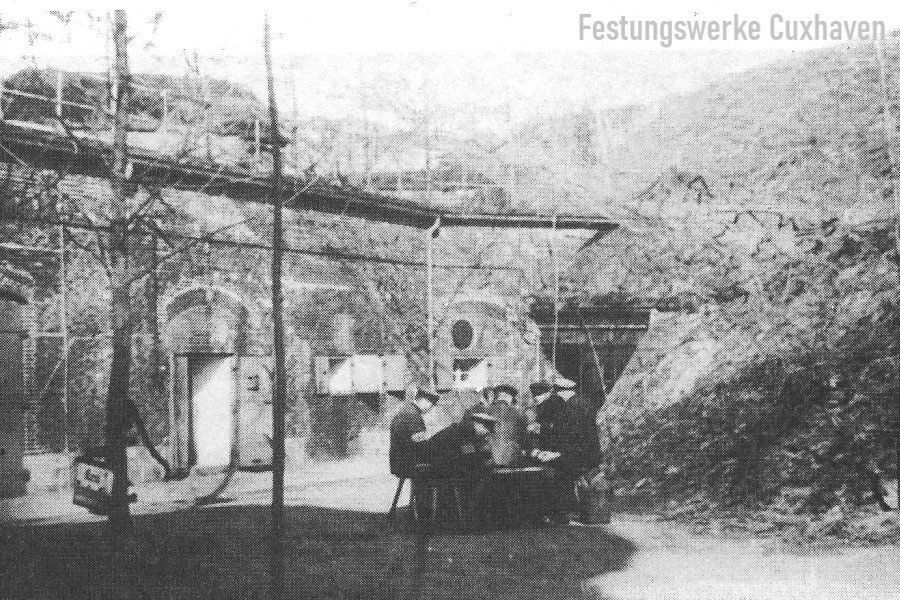
Russische "Kriegsfreiwillige" beim Kartoffeln schälen. Aufnahme vom Westhof mit Blick auf die Mitteltraverse.
Fotoquelle: Marinehelfer in der Batterie Kugelbake / 1995
Ab etwa Mitte 1943 wurden in der Festung Kugelbake genau wie in den anderen Batterien sogenannte "Kriegsfreiwillige" Russen eingesetzt. Ihre Aufgaben waren meist einfachere Arbeiten in allen Bereichen. Vor allen Dingen Transport von Flakgranaten zu den Geschützen oder Tätigkeiten in der Küche. Zwischenzeitlch waren es um die 25 russischen Kräfte die in der Anlage tätig waren. Sie sollen relativ große Freiheiten in der Festung gehabt haben, allerdings wurden sie Nachts in ihren Räumlichkeiten hinter einer dicken Stahltür mit Vorhängschloss eingesperrt. Nach Berichten von Zeitzeugen soll es sich dabei um Menschen mit zum Teil höherem Bildungsstand gehandelt haben, die ihr Wissen und ihre Fähigkeiten allerdings klein hielten um nicht unbedingt aufzufallen. Wie der Bezug "Kriegsfreiwillig" hier zu sehen war, ist nicht wirklich festzustellen. Vielleicht ließ man ihnen auf Grund von Mangel an Personalknappheit auch nur die Wahl zwischen als Kriegsgefangener ins Gefangenenlager oder Helfer in einer Flakbatterie des Feindes.
Fortress Kugelbake with the anti-aircraft battery from 1943
The drawings were provided by the historian Robert Marek Jurga, many thanks!http://robertjurga.pl/english
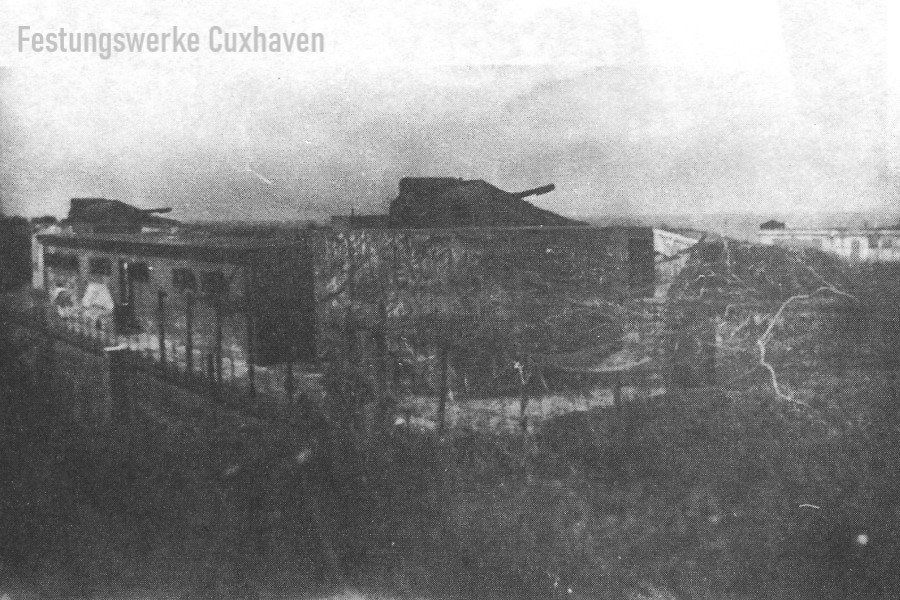
Guns 1 (right) and 2 (left) on their pedestals on the north side of the facility. In the middle is the soldiers' quarters. Photo source: Marinehelfer in the Kugelbake battery / 1995
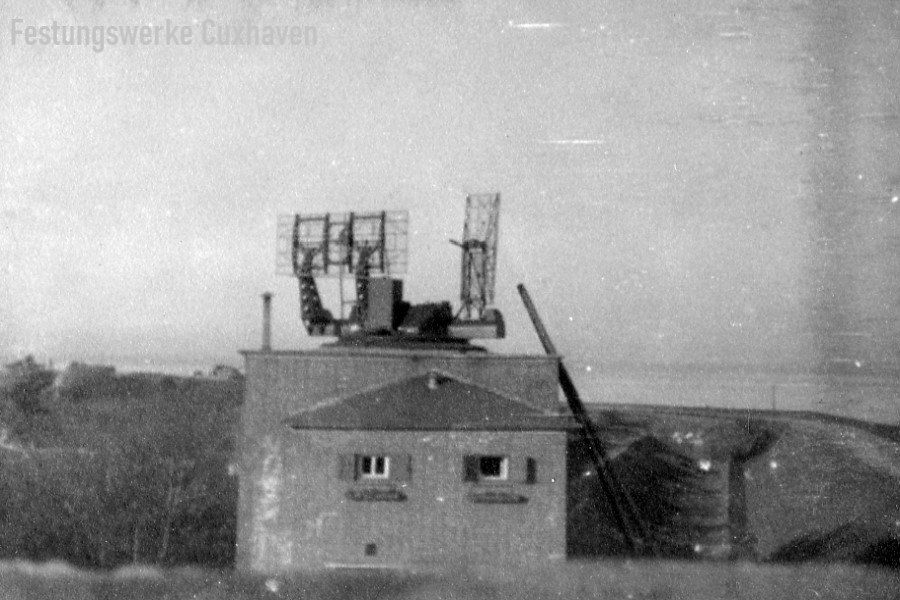
Installation of the FUMO 201 (Flakleitgerät 41) on control station 2, on the right flank. The tower was permanently manned by at least one lookout post and was directly connected to the command post for the transmission of messages.Photo source: Paul Remde
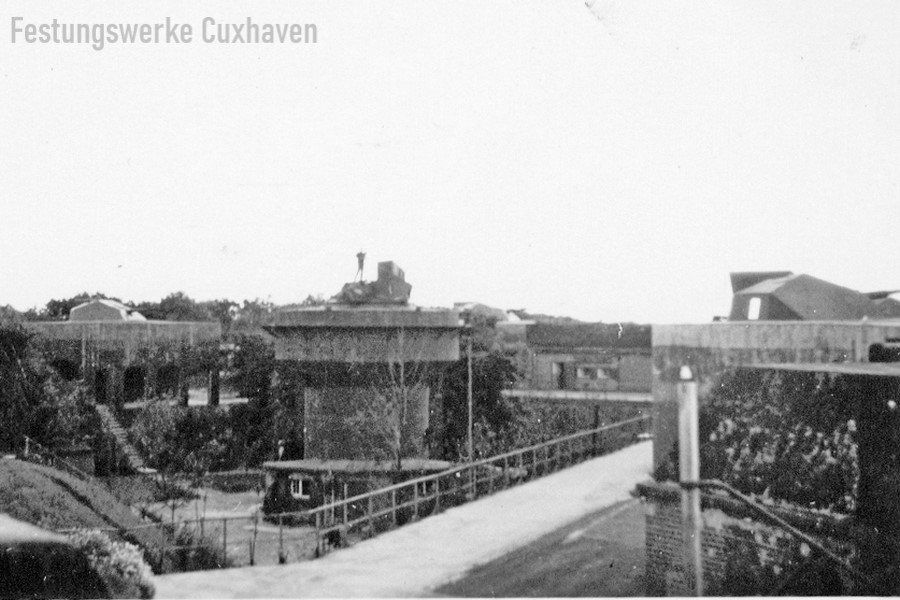
The western courtyard with control station 1, above the Dreiwag (command device) under the armored cupola with the 6 meter optics. It also had an anti-aircraft control device 40/A10 x 80 with two double telescopes and 40x magnification. Photo source: Hümer
Inserts of the Kugelbake battery
Zur Alarmierung der Batterie gab es verschiedene Stufen:
KWR = War Watch Rest - (normal state, or after the operation "all clear" meaning transition to everyday service operations, - at night "retirement for night rest")
EKW = Eingeschränkte Kriegswache (Feindflugzeuge sind im weiteren Bereich. Die Möglichkeit des Einfluges in unseren Raum besteht.)
KWA = War Watch Attention (enemy aircraft are heading for the German Bight. If they had not turned away, there was usually a
Alarm = All hands to combat stations, entering our area.
Alarm was usually given by the alarm bells which could be heard in every shelter and throughout the battery. The civilian population in the nearby houses could not hear this.
If members of the battery were in the mudflats, on the outer dike or in the wider vicinity of the battery, the battery siren located on control station 1 was triggered by the post there and an alarm was raised.
Then it was everyone's duty to find their gun or their combat station as quickly as possible. (At night - get dressed - start running. Every gun commander wanted to give his "clear report" as early as possible. Source: Marinehelfer in the Kugelbake battery-1995/Former Marinehelfer Harald Schönemann
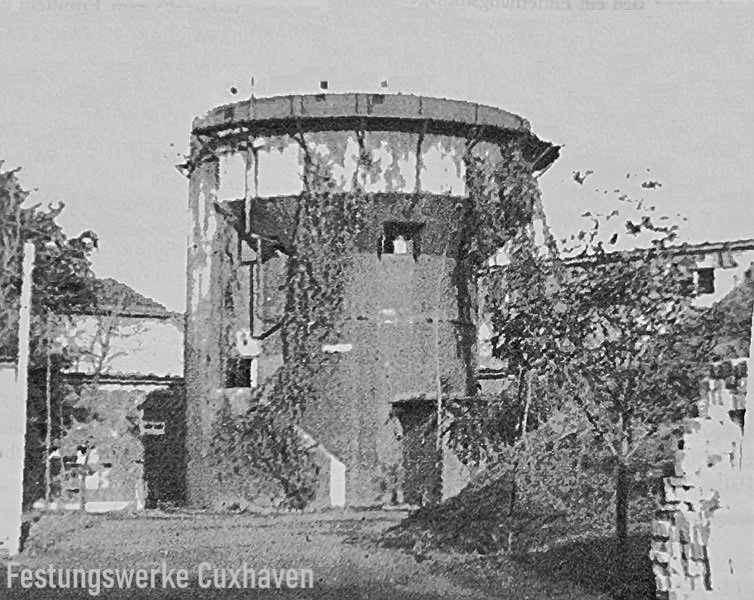
Leitstand 1 noch ohne das
Dreiwag. Der Turm war aus Beton gegossen und ging 1941 in Betrieb. Im unteren Bereich befand sich die Flakleitung mit der Befehlsübemittlung und zwischenzeitlich die Telefonzentrale. 1949 wurde der Leitstand 1, ebenso wie der Leitstand 2 im Rahmen der Entmilitarisierung durch die englischen Besatzungstruppen gesprengt. Seine Umrisse sind heute noch durch die entsprechende Pflasterung zu erkennen.
Quelle: Stadtarchiv/Gerd Wildfang
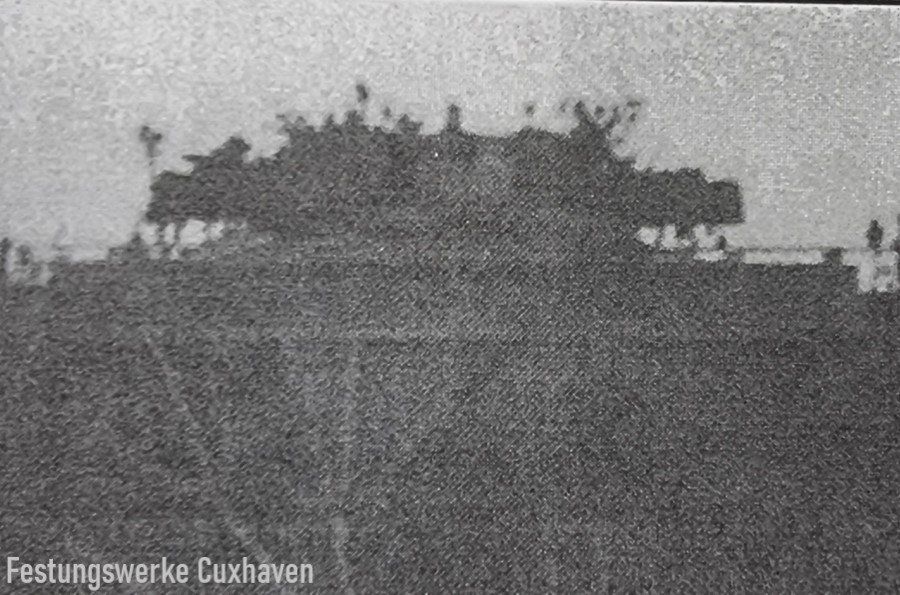
The heavy Dreiwag Küste on the control station 1Source: City Archives/Gerd Wildfang
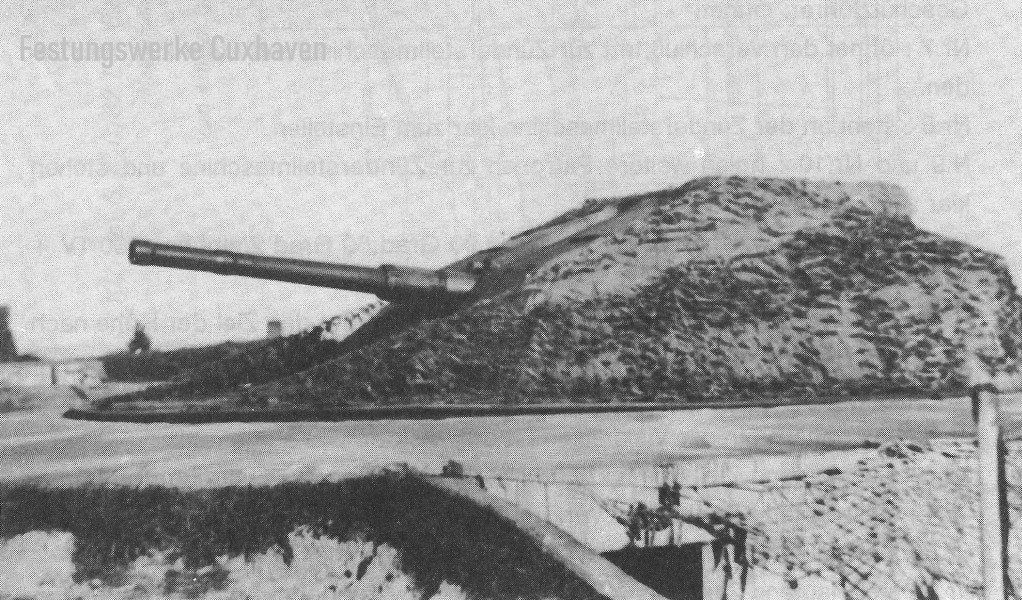
Gun 3Photo source: Marinehelfer in the Kugelbake battery / 1995
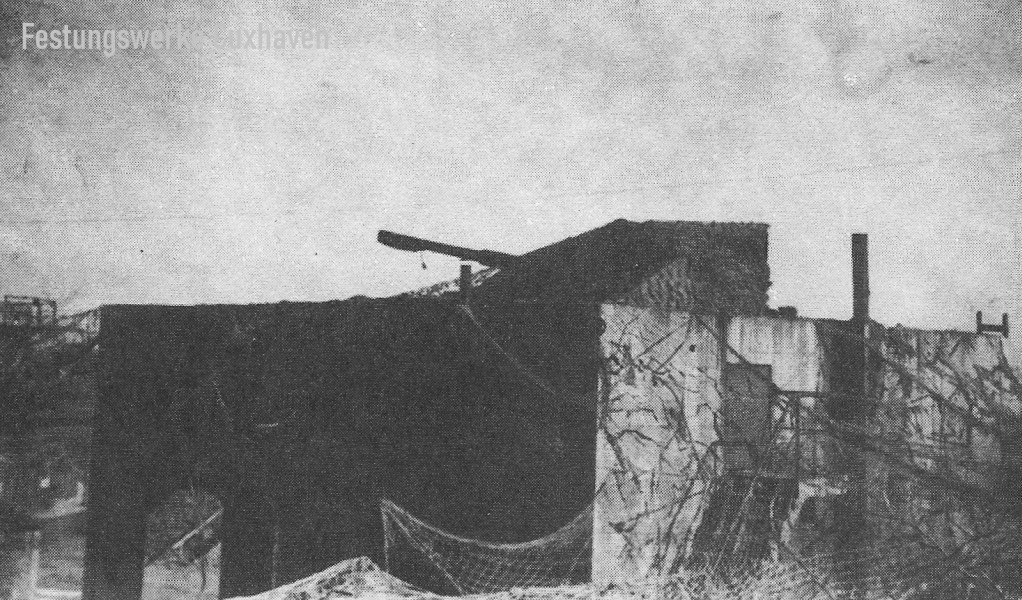
Gun 4 on its concrete boiler bedPhoto source: Marinehelfer in the Kugelbake battery / 1995
The ammunition stock of the heavy 10.5 cm guns in the battery always amounted to around 5,000 to 6,000 anti-aircraft shells, which were stored in the fort's ammunition bunker. There were always 250 shells per gun in two security boxes on site, ready to hand. The gun could rotate quite quickly, so two access points for the ammunition were needed to be able to maintain the salvo rhythm. Since the supply of shells from the fort's main ammunition bunker to the guns had to be done on foot, this work was usually carried out by the Russian forces, since a cartridge alone weighed 26.1 kg. The young naval helpers were not able to do this in the long term.Source: Gerd Wildfang
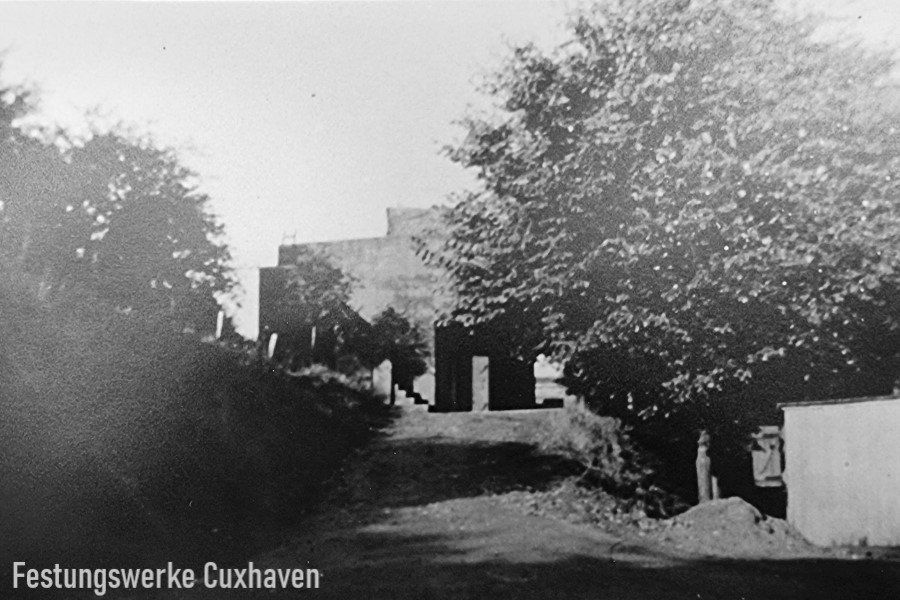
The ramp to gun 4Source: City Archives/Gerd Wildfang
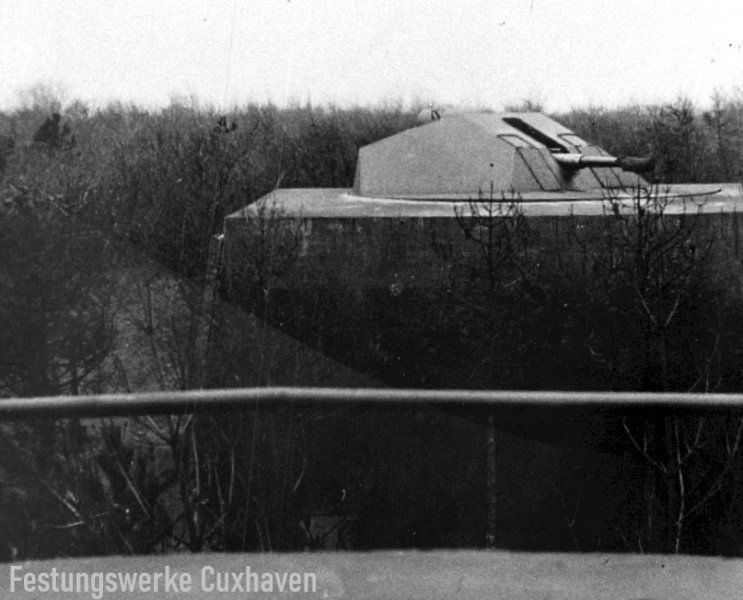
Gun 4 - An incident occurred during a shot at a too shallow angle in a northerly direction. The 2nd gun received a graze, but this had no major consequences. As a result, the area for guns 3 and 4 at this shallow angle was technically blocked off to prevent further accidents. Source: City Archives/Gerd Wildfang
Combat shooting for air defence
As the name suggests, the anti-aircraft chief was in charge of directing the firing from control station 1. Once the enemy aircraft had been spotted, the first thing he did was give the approximate elevation and azimuth angle and any altitude. The azimuth and elevation numbers (this refers to the operating personnel) of the measuring device swung the device according to these figures. Once they had the machines in their sights, the E-meter reported "Target detected! Target coming!". His job was to measure the distance to the target. Once this had been done, he reported: "Set!".
The values of elevation angle, azimuth angle and distance were sent electronically to the calculator (Kleinkog C5). The calculator determined the hit values based on the rate of change in the three areas. These were also sent electronically to the guns.
The windage and elevation numbers on the guns were used to align the gun using the follow-up pointer system. The distance was converted into fuze setting time and set on the fuze setting machine.
Durch Einlegen der Flak-Granaten in die Zünderstellmaschine und das maschinelle Einstellen des Zünders, waren die nötigen Vorbereitungen getroffen. Die Ladenummer schob dann die immerhin 26,1 kg schwere Granate (Patronenmunition) in das Rohr ein. Auf Zeichen des Flak-Leiters (Hubton) zog der jeweilige Geschützführer ab. So wurden in dem Augenblick alle 4 Geschütze der Batterie abgefeuert (eine Salve). Bis zum nächsten Abfeuern standen an Zeit nur 5 Sekunden zur Verfügung (Salventakt). Die Hülse wurde ausgeworfen, durch den Hülsenfänger geborgen und die folgende Granate wurde geladen.
Bemerkung: Man schoss also dorthin, wo das Flugzeug bei Beibehaltung der Geschwindigkeit, des Kurses und der Flughöhe voraussichtlich sein müsste (Vorhalte). Bedenkt man dabei, dass das Rechengerät die Werte errechnete, dann der Salventakt 5 Sek. ausmachte‚ dazu die Zünderstellzeit gerechnet werden musste, so kann man ermessen wie schwierig das Schießen auf bewegliche Luftziele war. In 25 Sek.kann sich vieles ändern!
Quelle: Marinehelfer in der Batterie Kugelbake-1995/ Ehemaliger Marinehelfer Harald Schönemann
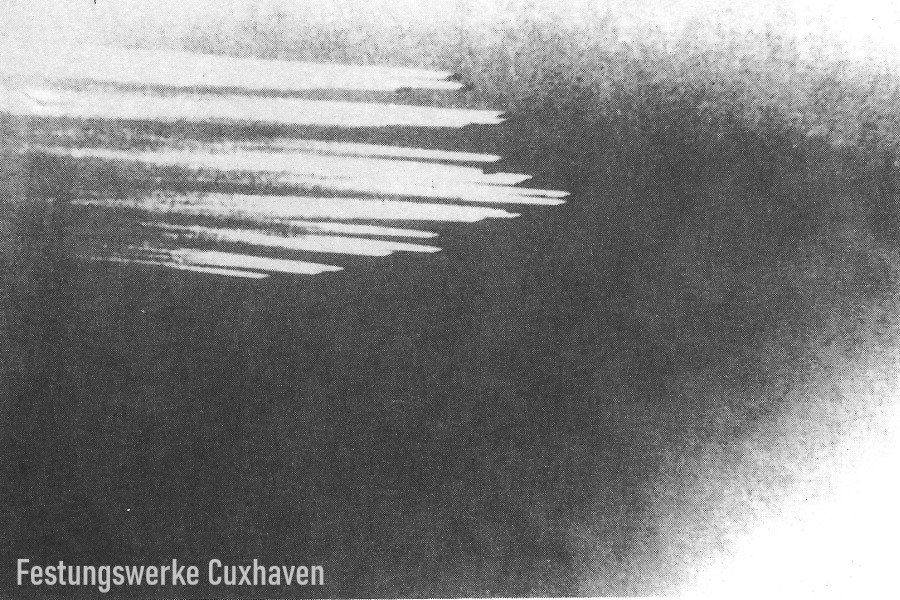
Bomber stream flying into the Reich territory over the Kugelbake battery. Photo source: Marinehelfer in the Kugelbake battery / 1995
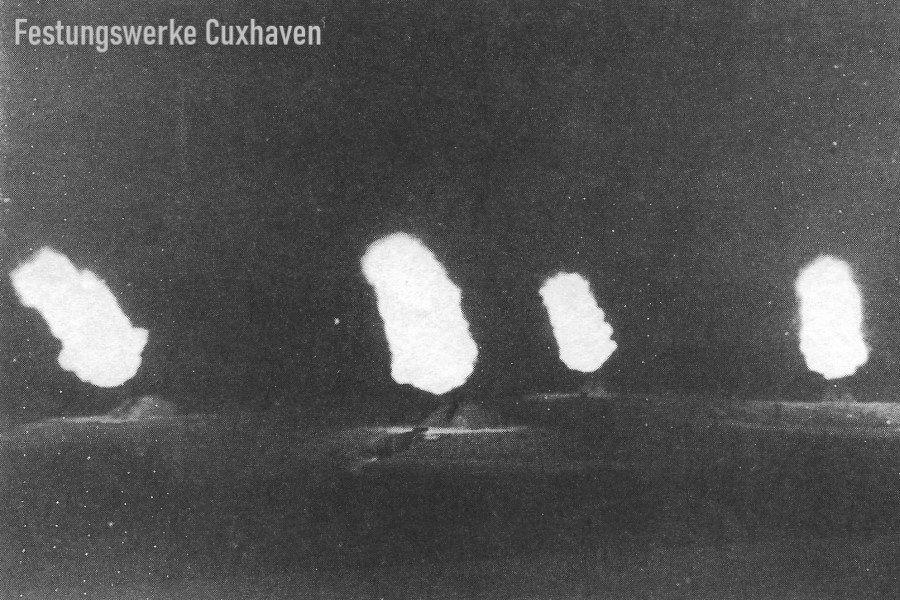
Salvo fire of the heavy anti-aircraft guns at the Kugelbake Fortress. Photo source: Marine helpers in the Kugelbake battery / 1995
Die Marinehelferinnen in der Batterie Kugelbake
When the naval assistants came to the battery, there were initially great concerns. Girls aged 17 to 20 were a problem for men who lived away from their families for months. So they were initially given accommodation outside the battery. They were assigned the eastern part of the staff barracks. The battery management attached great importance to creating a certain separation, as far as possible, even in official duties. At joint celebrations in the battery, the naval artillerymen, the naval assistants and the naval assistants sat in separate groups at the tables. On duty, separation and distance were always ensured. In their free time, however, the boundaries became blurred, but the presence of the assistants still added a little salt to the soup of community life. 50 years later, the naval assistant WH remembers her time in the Kugelbake: In April 1943, I received my call-up order. I was 17 at the time. My first place of service and training was Leer in East Frisia. A large barracks became our accommodation. From there we went to Heligoland for a three-month training course. After a short stay in Rügenwalde, we, around 20 to 25 naval assistants, were transferred to the Kugelbake battery in Cuxhaven at the end of 1943. In the course of the following period there were assignments, but I stayed in the battery for almost two years, until the end of 1945. Our duty consisted of level crossing watch, i.e. telephone duty in the command transmission, at the hatch cabinet, the lookout, watch on Flak-Ost and control center 1, duty at the small cog, the calculator and the E-measuring device. Only the artillerymen, the naval assistants and the Russians were at the guns - but no naval assistants. We were relieved at level crossing watch every three hours. Our duties also included noting down the reports that came in via air traffic, weather reports, as well as forwarding the alarm levels and writing down the battery reports. Record the text and time, that had to be done very quickly. Source: Marinehelfer in the Kugelbake battery-1995/ Former Marinehelfer Harald Schönemann
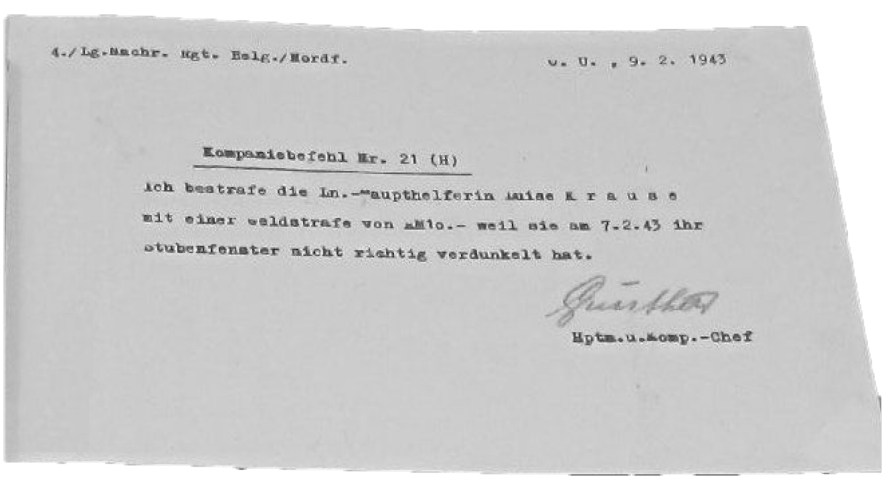
Picture left: Misdemeanors were punished immediately. In this case, during training on Heligoland, the room was forgotten to be darkened. In this case, this was punished with a fine of 10 Reichsmarks, which was a lot of money in those days. People were simply very afraid of night-time air raids and even the slightest lighting provided a good target for the attackers.
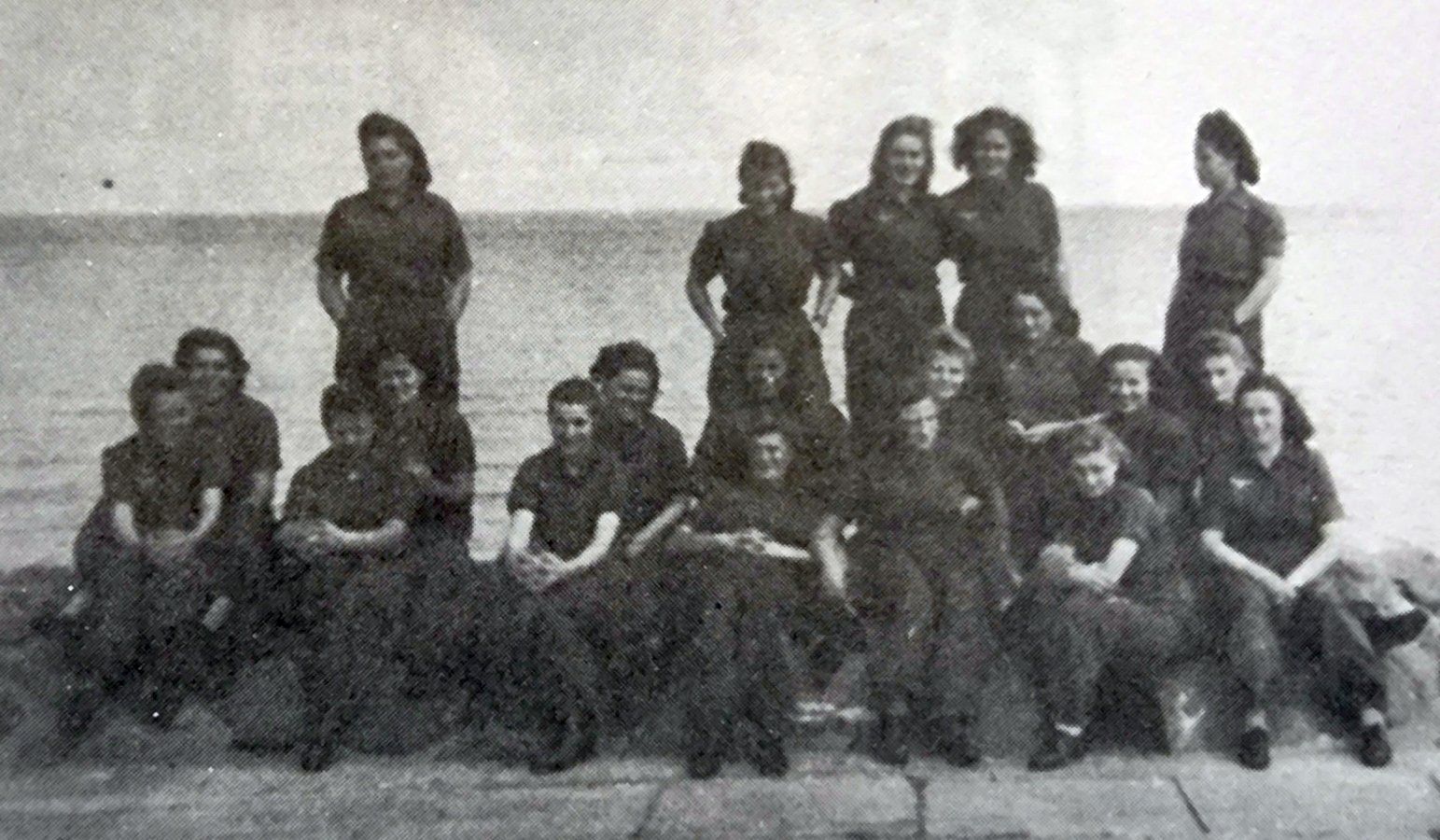
Marine helpers of the Kugelbake batteryPhoto source: Marine helpers in the Kugelbake battery / 1995
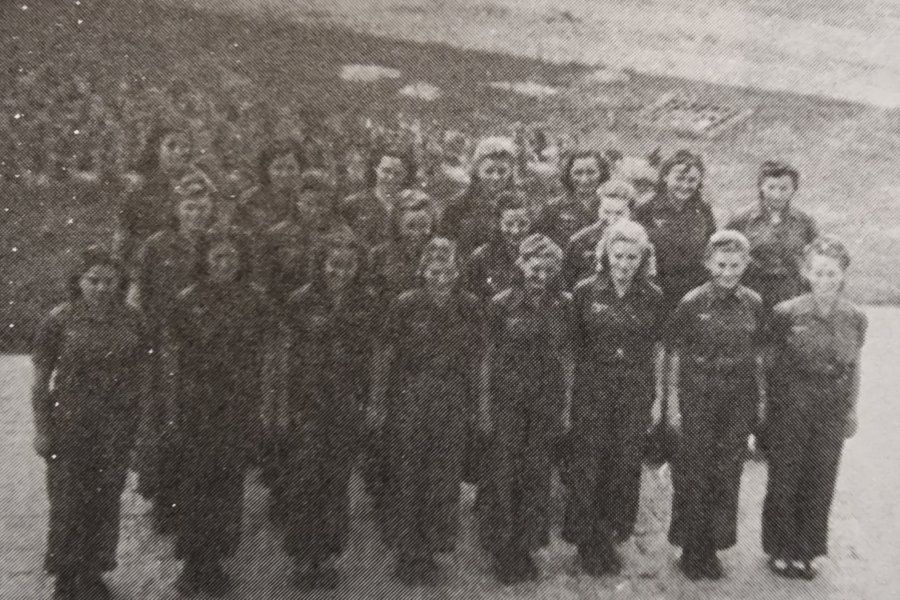
Photo source: Marine helper in the Kugelbake battery / 1995
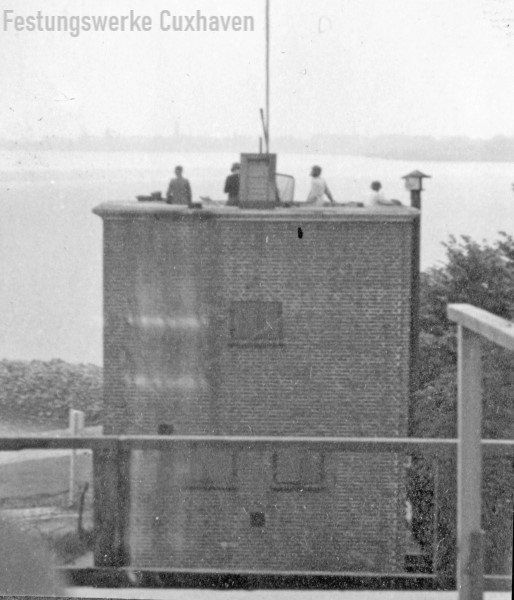
Flak high stand east, Grimmershörnbucht in the background. A light 2 cm Flak C30 was installed until the end of the war as protection against low-flying aircraft and for close-range target engagement. The former battery members are not aware of any later conversion to a quadruple anti-aircraft gun, as sometimes described.Photo source: Paul Remde
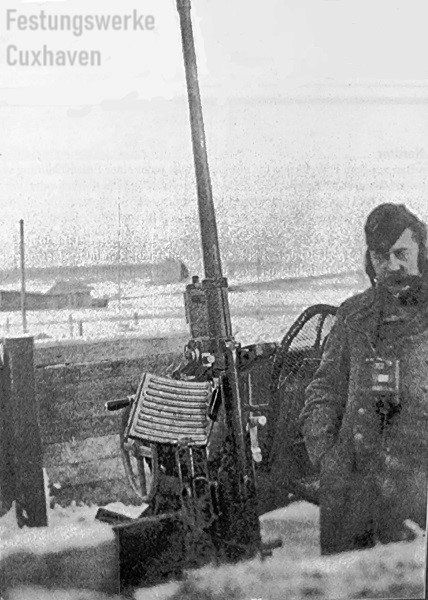
Theodor Leihfeld from Magdeburg at a 2 cm Flak 29 Oerlikon, here presumably on the dike in front of the Kugelbakehafen.Photo source: Theodor Leihfeld
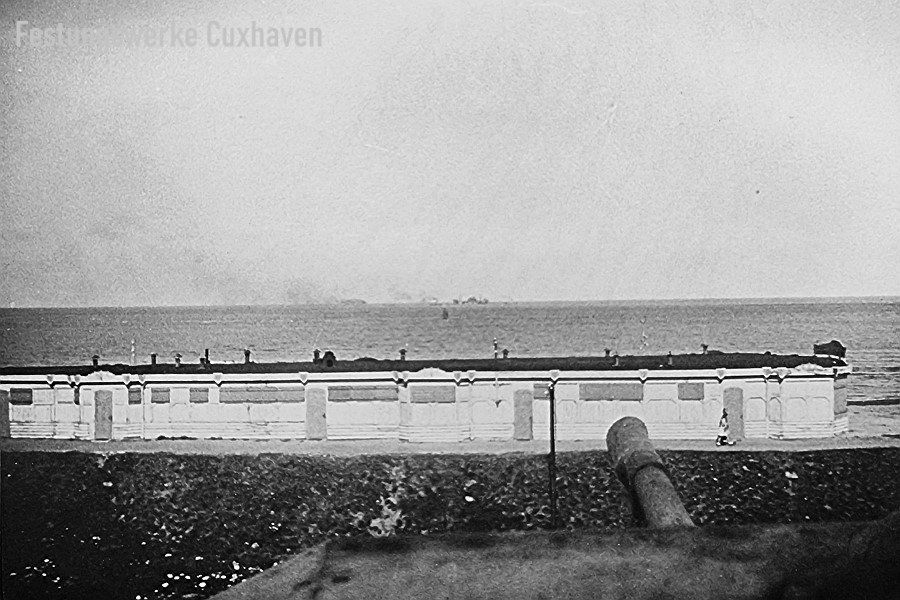
The former Döse beach hall on the dike, in front of it Gun 1. In the background ships on the Elbe.Source: City Archives/Gerd Wildfang
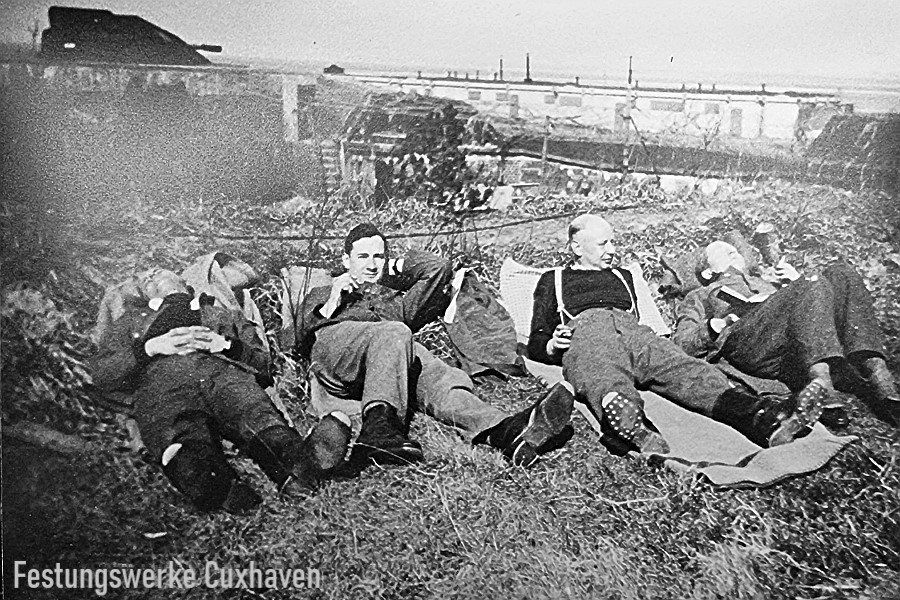
Resting on the central traverse, in the background the gun 1.Source: City Archives/Gerd Wildfang
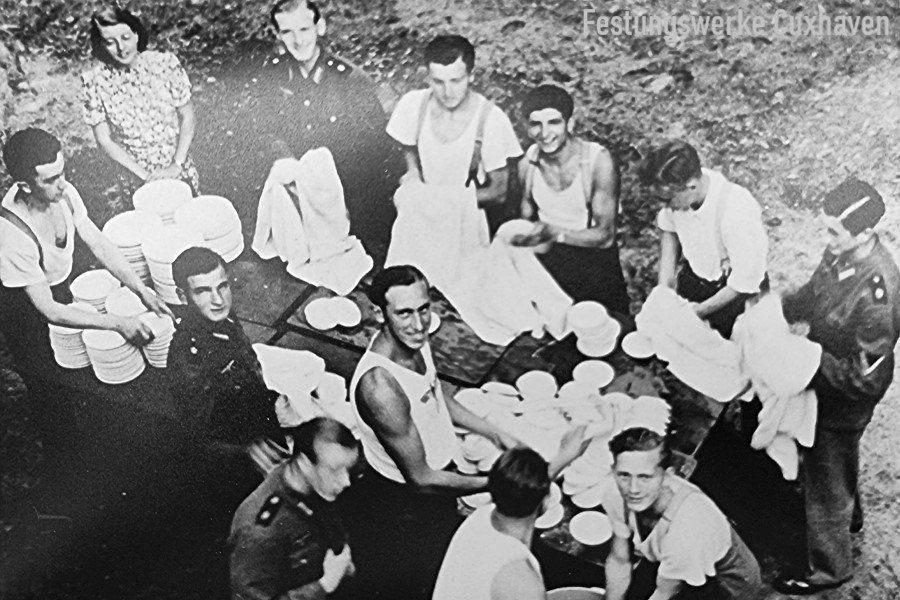
Washing up together in the yard. At that time, great importance was attached to good cohesion in the anti-aircraft batteries, as can be read again and again and was also confirmed by former members.Source: City Archives/Gerd Wildfang
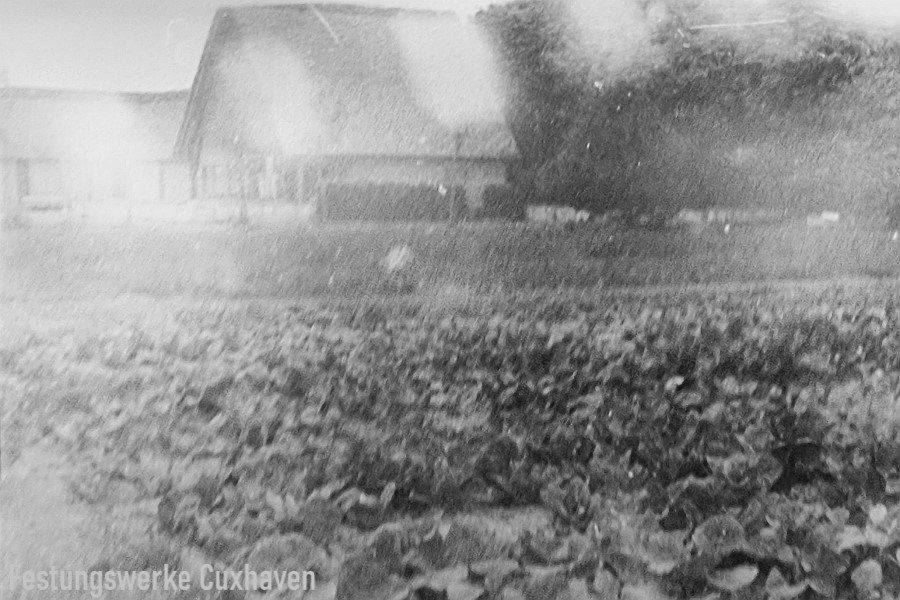
Döse spa park, the entire lawn area today was used as a huge vegetable garden during wartime to bring variety to the table. In the background is the spa park hall, which went up in flames on New Year's Eve on December 31, 2014 and was completely destroyed. Source: City Archives/Gerd Wildfang

Blick vom Ostwall der Anlage auf die Kugelbake. Im Vordergrund der Sicherheitszaun, dahinter der Steindamm zur Kugelbake mit den zwei Bunkern.
Quelle: Stadtarchiv/Gerd Wildfang
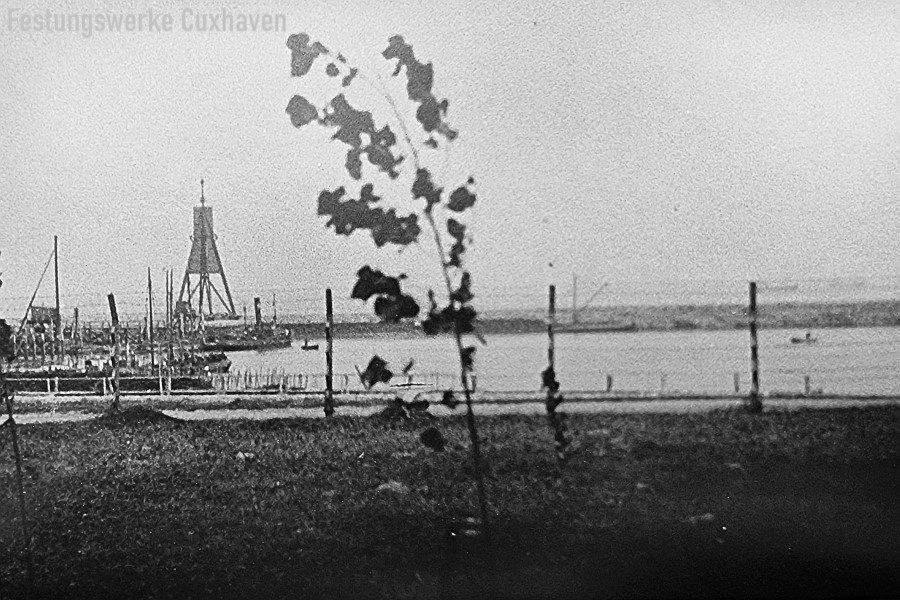
The Kugelbakehafen, on the dike the security fenceSource: City Archives/Gerd Wildfang
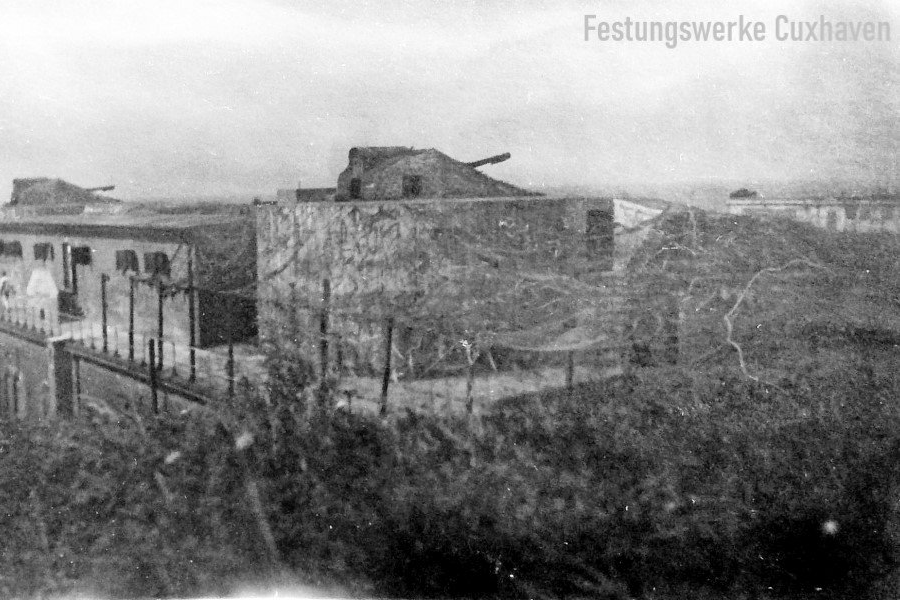
The anti-aircraft guns 1 and 2 on the north side of the Kugelbake fortress, on the far right the beach hall.Source: City Archives/Gerd Wildfang
Events from various official war diaries of the naval command 1939 - 1945
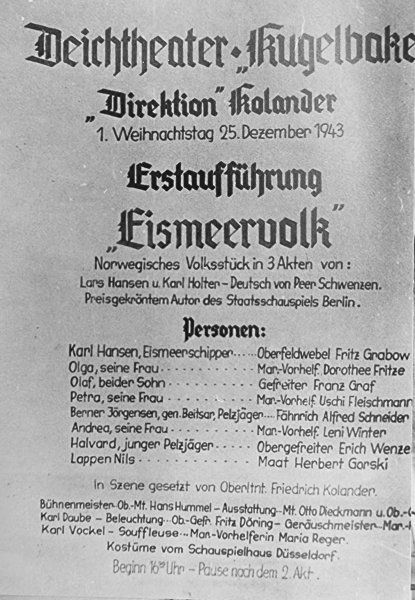
For the entertainment and cultural motivation of all battery members, there were regular celebrations or performances such as the play "Eismeervolk" on Boxing Day 1943.Source: City Archives/Gerd Wildfang
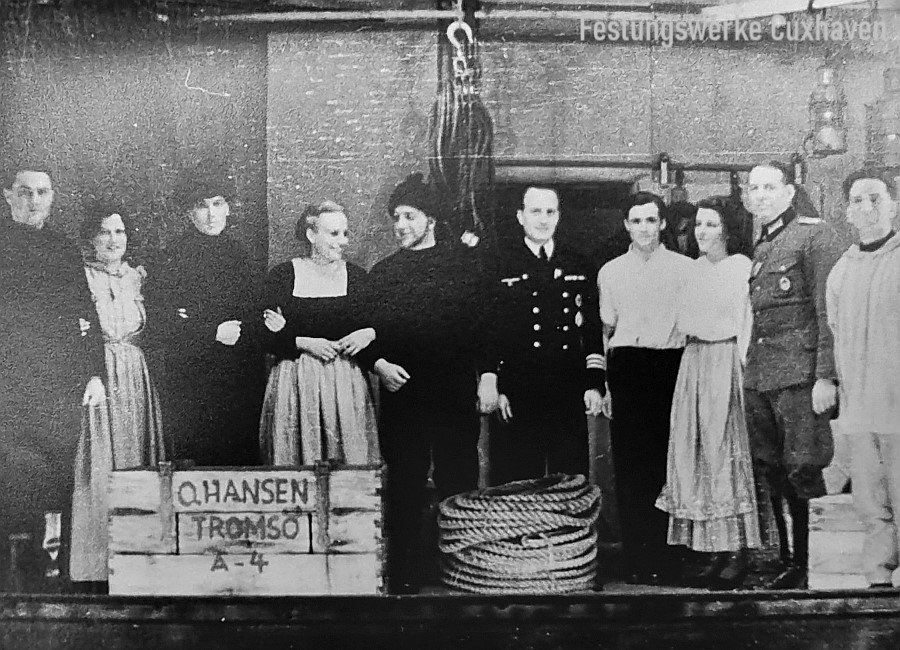
The stage crew of the Kugelbake battery. All of them soldiers and naval assistants from the anti-aircraft position of the fortress.Source: City Archives/Gerd Wildfang
The last days of the war in the Kugelbake battery
1945 war der Außendeich bis zur Einfahrt gesperrt. Im Kugelbake Hafen lag ein Kohlenschiff, das bewacht wurde. Mit den Wächtern kam man ins Gespräch. Sie wurden mit Spirituosen und Zigaretten bestochen, und so ergänzte man in den Batterieunterkünften den Vorrat an Kohlen.
Ein Ereignis rief damals einige Bestürzung hervor. Ein Batterieangehöriger aus Tangermünde hatte eine "Schwarze Liste "aufgestellt. Er wollte Kugelbake zum Stützpunkt erklären und ihn gegen alle feindlichen Angriffe halten. Alle, die auf dieser Liste standen, sollten im Ernstfall erschossen werden, als erster war der Batteriechef aufgeführt. Der Marinehelfer hatte sich dafür bereits eine Pistole besorgt. Doch da sich die Ereignisse überstürzten, blieb der Plan zum Glück unausgeführt.
As the enemy troops came ever closer and faster, the end of the war was already in sight. There was a fear that the fortress would be destroyed by bombs or artillery fire. This suspicion was given new impetus when reconnaissance aircraft were spotted over the battery. In this uncertainty, the battery commander ordered the naval helpers to march to Brockeswalde and Sahlenburg. In doing so, he risked having to report the battery as "unclear" in the event of an attack. At that time, this would have inevitably resulted in a court martial.
On May 7, 1945, the English approached from the Kugelbake battery in Cuxhaven. They drove carefully along Strandstrasse in several armored reconnaissance vehicles. Alert and always ready to shoot if there was any resistance. At that time, the cherry trees were in bloom in the front gardens - it was May, after all. The English then sat down in front of the driveway and both sides were relieved that no shots were fired. Since there was an election in England, the first thing they did was connect the radios and wanted to know the result. The Highlanders were in a friendly mood. We were ordered to pack up all our things and load them onto wagons belonging to Oelkers, who had a tractor. In addition to our personal belongings, which took up very little space, we loaded them with meat and sausage products, canned goods, pulses and other food. Then we left the battery and marched to Brockeswalde for internment. We had plenty of food to choose from. Even red wine and rum were available.
Almost all of us were taken prisoner in Freiburg/Elbe. A tent city with electric light, beds and mattresses was set up on a farm near Öderquart. The Wehrmacht members who worked in agriculture were released first. I claimed to know something about agricultural machinery and was released from the camp that way. According to the memories of Marinehelfer GMSource: Marinehelfer in der Batterie Kugelbake / 1995
Further background reports on the Kugelbake battery
Fort Kugelbake after the war
Immediately after the war, the British armed forces took over Fort Kugelbake and began to demilitarize the facility. All the guns and control centers 1 and 2 were blown up and thus rendered unusable. The scrap metal and debris were gradually removed. Meanwhile, refugees, many from the island of Heligoland, had already moved into the former fort, the Nissen huts and the buildings in the area of the staff barracks. The conditions on site were not the best, with sanitation and drinking water being the biggest problem at the beginning. But the people mostly stuck together and made the best of their difficult situation. According to stories, however, the fort was a paradise for the children with its walls, the trees and the grounds behind it. Later, after most of the refugees had left, the first small businesses settled in the complex, including the Schmidt iron foundry. After that, the former fortress fell into a deep sleep.
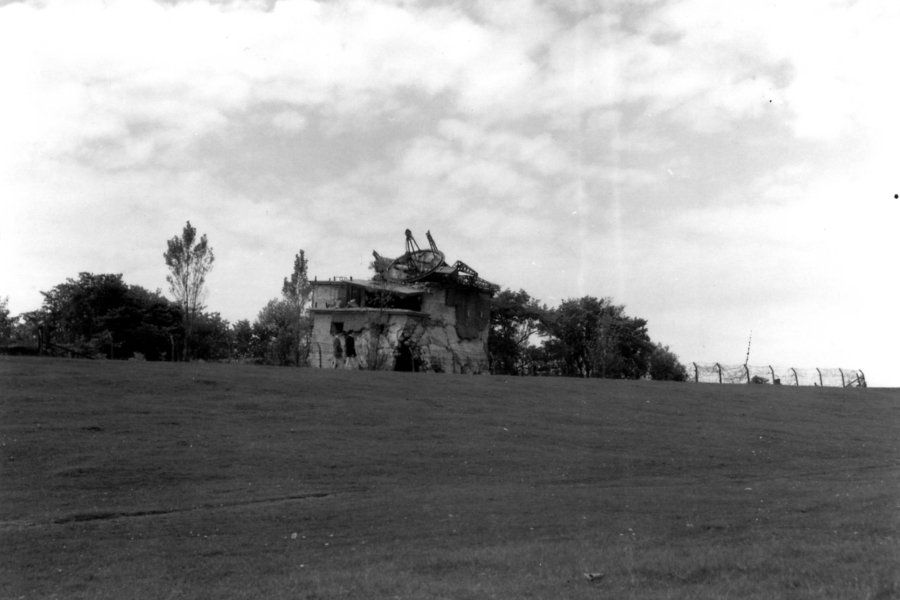
The blown up control center 2 on the dike on the northeast side in 1949. Photo source: Chales S. Perry Zachary
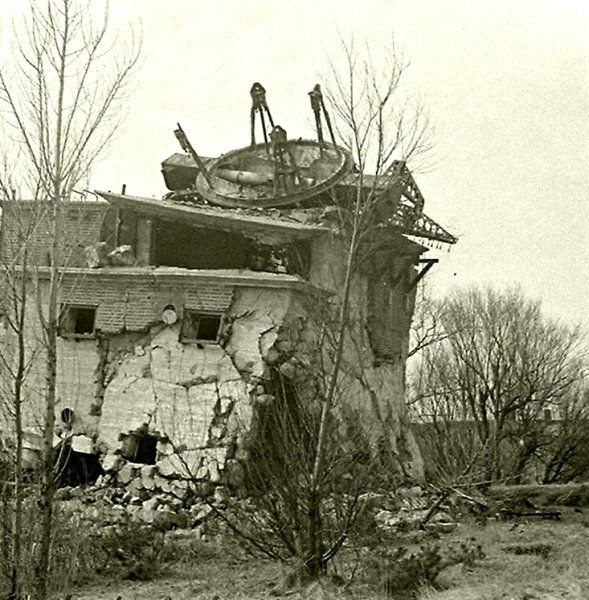
The FUMO 201/202 on the completely destroyed tower.
Fotoquelle: Chales S. Perry Zachary
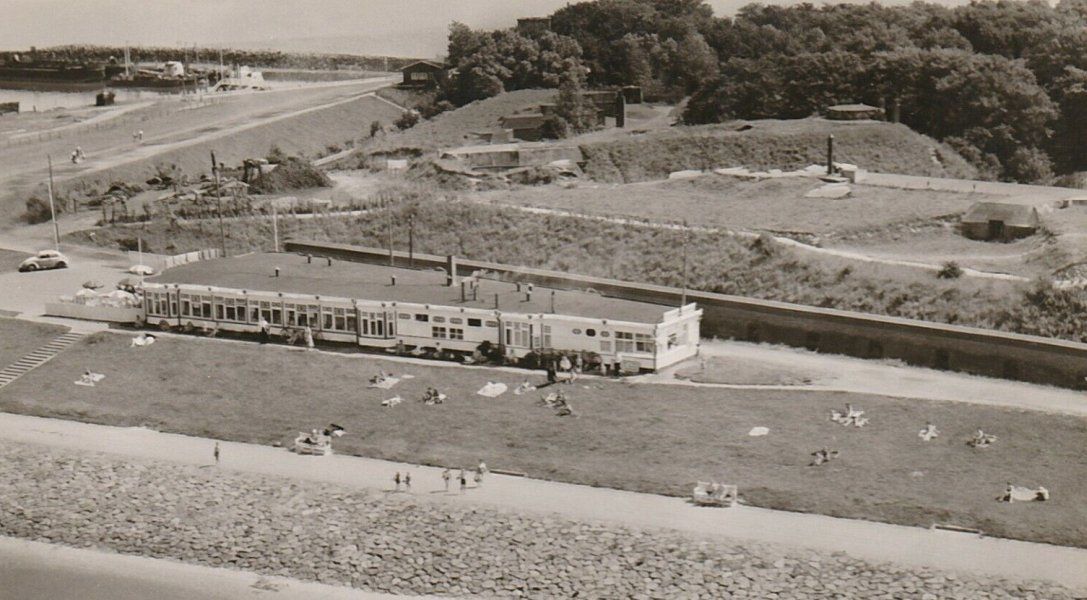
Fort Kugelbake in the 1950s, most of the rubble has already been removed.
Fort Kugelbake today
It was not until the 1990s that work began to restore the fort to its former glory. A significant portion of EU funding made it possible to renovate the structure of the fort and stop its deterioration for the time being. After the work was finished, it was in excellent condition, even old guns such as the 10.5 SKC and an 8.8 cm Flak 39 and a small museum in the former crew bunker were installed and set up. Many festivities, celebrations and events such as the first Deichbrand Festival took place in the courtyard. In the meantime, operations have been completely stopped and the fort has returned to its deep sleep. Time, weather and vegetation have also taken over, so that the historic complex has started to deteriorate again in many places. After the renovation in the 1990s, people mainly lived off the substance, but after that, due to tight budgets, not much was really invested in maintenance. A tour of the complex is still possible today, and is offered by the Cuxhaven Events Center.
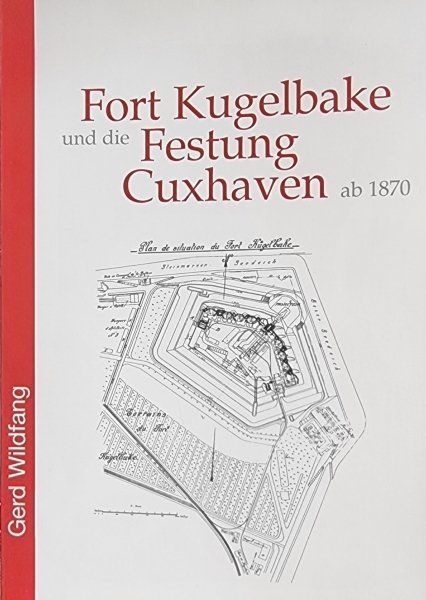
Further and much more detailed information about the construction of Fort Kugelbake and the anti-aircraft battery of the same name, with many photos, maps and plans, can be found in Gerd Wildfang's paperback. It is available at the Kugelbakehalle Döse event center - Strandstraße 80. Tel. 04721-404200
Special thanks go to Gerd Wildfang for his support with photos and his extensive expertise on these topics. Also to the Schönemann family for allowing photos and texts from the booklet "Marinehelfer in der Batterie Kugelbake von 1995" and also to the kind support of the employees of the Cuxhaven City Archives.Martin Brütt



